Body Language in Presentations
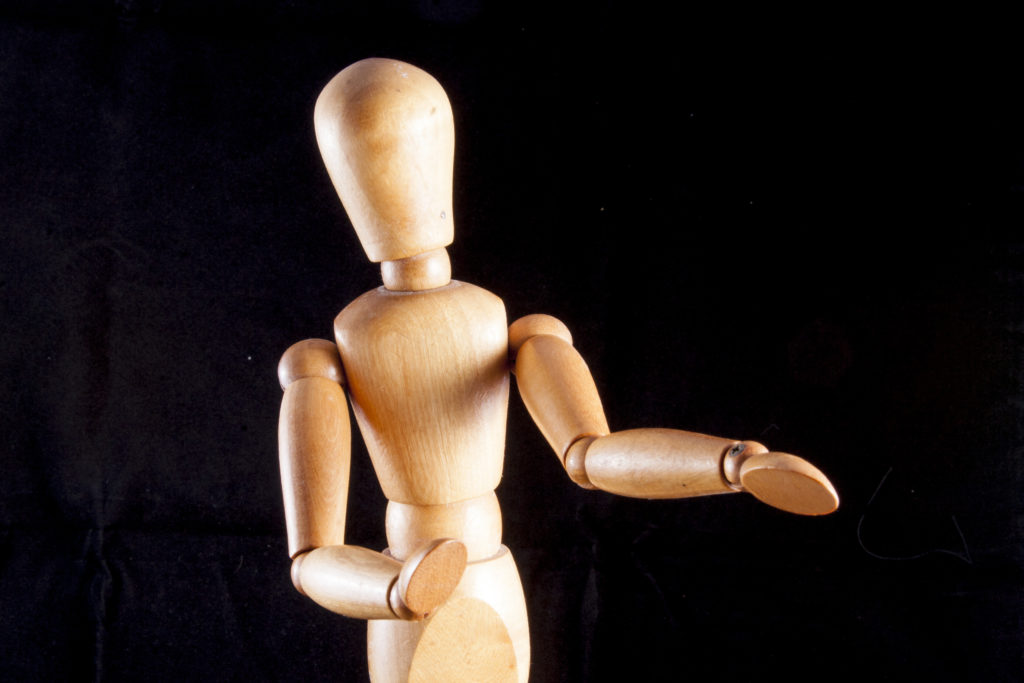
The words you use during your talk certainly matter, but the body language presentation cues that you project are as important – if not more so – in getting your message to land as you intended.
The gestures you use, the eye contact you make, the expressions you convey, and your very movement through a room offer a multitude of nonverbal signals to your audience.
It’s through these body language presentation cues that an audience will make assessments about your credibility, your expertise, and your passion for the subject, as well as whether you are qualified to seek followers for the cause you are advocating, to suggest the changes you are recommending, or to pitch the product you are selling.
Even something as seemingly small as the number of seconds you maintain eye contact with your audience or the decisions you make about what to do with your hands when presenting can make a difference. It boils down to the impression your words and your actions are making. And as researchers have discovered, first impressions are formed in mere seconds and are often quite accurate and long-lasting. In a well-known study led by the late Nalina Ambady, a professor of psychology at Boston’s Tufts University, students who watched two-second video clips (with the sound muted!) of a group of professors formed similar impressions to the ones drawn by students during a full semester.
So how do you exhibit the right body language for presentation success?
Effectively using body language in presentations takes skill and practice. But before we get into the tips and strategies for how to achieve the right look and tone, let’s look at the basics of body language in professional presentations, as well as why it is important to be aware of your body language while giving a presentation.

What is the Importance of Body Language in a Presentation?

The proper body language in a presentation helps to convey that you have confidence in yourself and your message. A speaker who knows the importance of body language in an oral presentation can instill trust in the audience, which, among other things, helps to forge a connection. Further, a presenter who knows how to effectively employ body language presentation skills can help to emphasize the ideas that matter most.
If you are genuinely passionate about your subject, show it. A lackluster delivery not only belies your enthusiasm, but also does nothing to enhance the meaning and effectiveness of your words. What should your audience believe? The words you use to share how excited you are to be there, or the flat tone with which you delivered them? Typically, they’ll assume your monotone delivery is more indicative of your true feelings than your words.
Great physical communicators learn how to successfully align their facial expressions, gestures, movements, posture, and other nonverbal elements with their message.

Photo by Element5 Digital on Unsplash
Presentation Body Language Basics
If you were delivering sad news, would you do it with a smile, a bright voice, and a bounce in your step? Or would you deliver it with a serious expression, a somber tone, and less pep? Any incongruity between your actions and your message is going to make it difficult for your audience to process, understand, and retain your message. You want your audience to be concentrated on your message and not the misalignment between your nonverbal movements and verbal delivery.
Your physical presence reveals your mental and emotional state to your audience – and everything about that presence should project that you feel comfortable, are in control of the room, and know your stuff. When it comes down to how to use body language to improve your presentation, it’s a matter of focusing on several key areas of your physical movements, including your eye contact, your gestures during presentation , and your presentation posture. (You can learn more about vocal cues here .)
When we work with our clients during our public speaking training sessions , we focus on how even small adjustments can make a difference in their delivery – such as a subtle shift of the shoulders, a more open stance, increased eye contact with their audience, and more natural and authentic gestures.
All these adjustments in your body language in a presentation can help to encourage audience participation, provide greater emphasis to your words, help you to appear and feel more natural, and increase your connection with the audience.
Eye Contact in Presentations: Why It’s Important
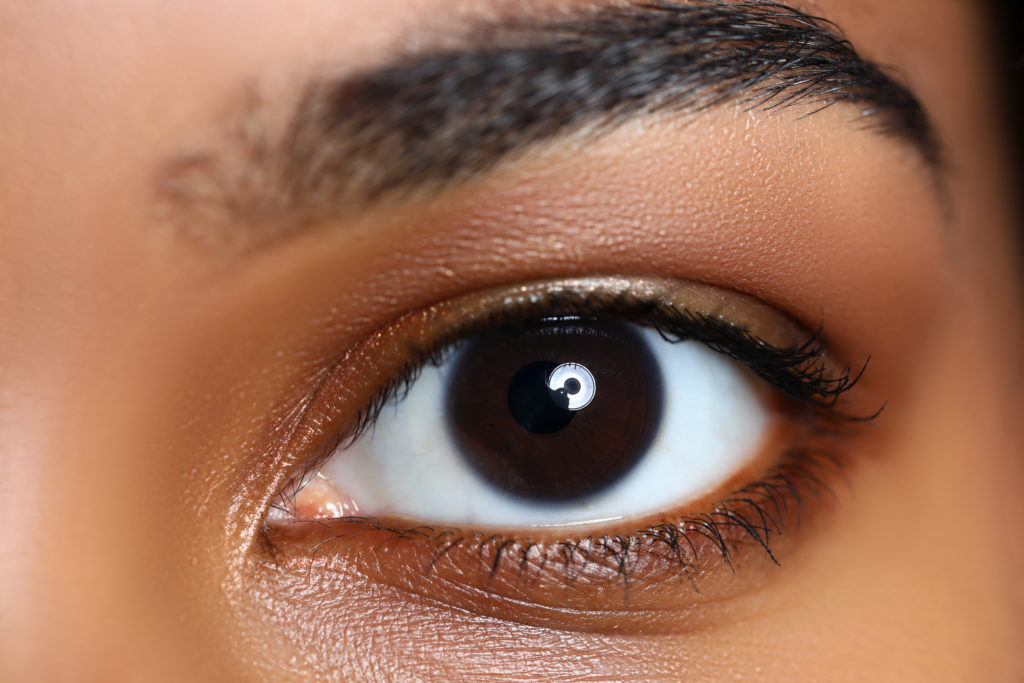
Given there is a large body of research that reveals just how influential eye contact is when it comes to the assumptions, judgments, and perceptions people make about one another, it’s important to give more than, shall we say, a passing glance to how you plan to move your eyes about the room.
Authors, researchers, seasoned speakers, consultants, and trainers vary slightly on the exact amount of time to maintain eye contact with someone in your audience. It appears that a few seconds is the going rate. Or, to translate that into words – a sentence or two. We tend to approach it differently. We’ve found most speakers naturally strike a reasonable balance of how long to maintain eye contact with one person before moving on. If they focus too much brainpower on counting the seconds or tracking their sentences, it can trip them up.
So, instead, here’s a simple rule:
When looking at your notes, your slides, or any other place than your audience, you should not be talking. Any time you are communicating information, you should be looking at an audience member.
And you don’t want to be looking at just one person all the time. It’s important to have effective eye contact in your presentation skills toolbox. In this post , we dive more deeply into effective ways to lock eyes with multiple members of your audience, depending on the type of presentation and venue.
How to Use Facial Expressions in a Presentation
Animated and dynamic speakers know they have a fuller palette of expression to help tell their story when they enlist the more than 40 muscles in their face to move their eyes, nose, brows, and mouth. It is through facial expression that we convey emotions, including seven universal emotions identified by psychologist Paul Ekman through his decades of work. Researchers have found that your audience is likely to make assumptions about you, such as how intelligent, trustworthy, or confident you are, based on your expressions.
Here are some tips on how to better communicate through facial expressions:
Smile. Unless the material requires a more serious expression, smiling while presenting tends to convey warmth and competence, which can help you to connect with your audience. Be expressive. This is not a license to be a mime, but rather, to use your expressions to relay your enthusiasm, your excitement, and to reinforce and support your key points and ideas. Just as presenters are encouraged to expand their vocal range to avoid a monotone presentation, so too is it important to avoid a static expression throughout your entire talk. Observe your audience. Do they look confused? Disinterested? Just as your audience picks up cues through your facial expressions, you too may be able to make perceptions about your audience. (Just be mindful that not every neutral expression indicates boredom or disinterest.) Hone your talent. As with any language, using and practicing it leads to mastery. Nonverbal language is no different. As you practice and rehearse your talk, think about what your facial expressions are conveying and if they are effective. Do they align with your words? Do you appear natural and authentic? Do they support and reinforce your key ideas?

Correct Body Posture During a Presentation
It’s hard to think of a single situation where slouching would be advised – and a presentation is no exception. The correct presentation posture if you are standing is to …
- Square your shoulders with the audience
- Relax your stance. You are not standing at attention!
- Face them directly instead of tilting your body away from them. (The exception to this rule is when you are soliciting feedback from your audience. In that case, turning your body at a slight angle can encourage engagement.)
The correct presentation posture if you are sitting is to …
- Lean forward slightly
- Plant your feet firmly on the floor (avoid crossing your legs)
- Avoid slouching into the chair
Beyond the confidence this posture projects to your audience, researchers have found when you throw those shoulders back or sit upright in your chair, that feeds into your self-confidence , too.
How to Improve Body Language for Presentations
The best way to project body language in a presentation is to be natural. And while it may sound counterintuitive, one of the ways you can appear and feel more natural in your movements is to practice them. This is why it’s important to save some time for rehearsals or practice runs.
Some of the best ways to test your material and your delivery are to record yourself, offer a practice run to an audience of colleagues or friends, and recreate the run-through so that it is as close to the live event as possible.
And, please, this is not the time for harsh criticism. Use this opportunity to see where you did well, such as projecting a confident smile, standing tall, and maintaining meaningful eye contact. Also, look for the areas where you can improve. Did you employ effective body language with your PowerPoint presentation slides? (Here’s are some specific ways to improve your PowerPoint presentation through body language and gestures.)
If you were on a panel, did it appear as if you were slouching? Did you appear nervous or ill at ease? (Here are some ways to counter your fear of public speaking . ) Use this time to hone your skills. Every presentation – whether practice or “live” – is a chance to improve.
Success occurs with preparation, and growth occurs with practice, whether you are a novice or seasoned pro. Here are some specific ways to make the most out of that preparation.
Practice in Front of a Mirror

Record Yourself
There are several reasons that video recording a practice run-through – either with a camera or smartphone – will help your presentation run a whole lot smoother. In addition to tracking such things as your timing, your pace, and the overall flow of your presentation (For example, do you vary the time for each main point? Do you have a mix of message supports, including statistics, stories, and slides?), you also can analyze your body language. Here are some of the things you want to look and listen for:
- The pace, pitch, and tone of your voice and how effective those elements were in conveying your main points.
- How well you maintained eye contact with your “audience.”
- Your gestures and whether they add emphasis to your talk and reinforce key ideas.
- Any mannerisms that are creating distractions, such as pacing in a predictable pattern, fidgeting with your tie or jewelry, or constantly brushing your hair back.
Watch the tape, identify the two or three things you want to improve upon, and do another practice run. If you improve, add another element, and then do another practice run if you have the time.
Learn how to control your body language during a presentation!
Work with our experienced Throughline Group trainers to identify and use effective body language, including energy, gestures, and posture. Sign up today!
Rehearse in Front of Team Members
While a video recording can be an effective way to assess your presentation skills, rehearsing in front of an audience of colleagues is key to getting a feel for the “real” thing. It gives you a chance to assess the nonverbal communication of your audience in real-time, and make the body language presentation fixes that will help you to increase your chances that you are connecting with your audience and helping your messages stick. You can make these sessions more effective in several ways. They include:
Treating your practice like the real thing. Avoid caveats or skimming through sections ( “When I really give my talk, I’ll tell a funny story here.” ) Asking for honest reactions. Your team may be rooting for you, but they need to react honestly if your words are falling flat, your energy is low, or you are spending too much time looking and reading from your notes. Embracing slip-ups, technical difficulties, and distractions. You may be tempted to start over, but plow through any hiccups so you gain the confidence and experience in dealing with difficulties before your talk goes “live.”
( Here are 20 questions you can ask your practice audience. )

Additional Presentation Body Language Tips
Your facial expressions, your posture, and your eye contact are all important elements in your nonverbal delivery. But you have other body language presentation cues that you also can use to make your presentation more effective. Remember, your hands can do some “talking” and your feet can do some walking in the service of your speech.
Hand gestures during a presentation can be used to do many things, including:
- Adding emphasis to a word or point
- Pointing something out on a slide or other visual support
- Reinforcing a concept
In practice, this means you might hold your fingers up for each point you want to make ( “No. 1 is this …” ). Or, with an outstretched hand – palm open – you direct your audience’s attention to a point of data on your chart. Finally, if you are comparing two recommendations perhaps you pantomime a scale with your hands, indicating that one side should win out over the other.
As for movement, unless you must stay tethered to the lectern, make the most of your space. Movement is one way to keep your audience alert and its attention on you. This leads to a more dynamic presentation and better connection with the audience.
When done with intention and confidence, your gestures and your movement – really, your overall body language in a presentation – will help to solidify your credibility, reveal your control of your material and the room, and help you to emphasize your key points.
Here are some specific tips on how to incorporate these additional body language presentation techniques into your talk.
What To Do With Your Hands During a Presentation
You may have been told it’s best not to gesture when speaking, but in our work with clients we have found that speakers become less anxious, appear more natural, and remember and retrieve their words far more effectively when they gesture during their presentations.
And the research backs that up. Gesturing not only adds emphasis and verve to your words but also can help you to better remember what you want to say.
However, there is a difference between gesturing and fidgeting. For instance, when you hold out your hand with the palm facing up when calling on someone during your Q&A, it is an effective and open gesture. It encourages engagement and connection. But, if you are hands are in constant motion, such as clasping and unclasping your fingers, twirling the ring on your finger, picking at your nails, or touching your face or hair, then your gestures can become a distraction.
When gesturing, remember to:
Be authentic. Start with what comes naturally and work from there. Forced movement will be seen for what it is – forced. Be purposeful. Trade fast, undisciplined hand movements during the presentation for gestures with intent. Be open. Avoid gestures such as pointing at your audience, gesturing toward them with your palm down, or crossing your arms – all of which can have a negative connotation or make you appear “closed” off and inaccessible. Be aware of cultural differences. Although certain presentation hand gestures and expressions fall under a universal language, gestures do not necessarily mean the same thing in every culture. For instance, your OK sign may mean just that, but to a person from another country, it might just be highly offensive. (Here’s a look at some of the more common nonverbal faux pas.)
What if My Hands Won’t Stop Shaking?
Anxiety has a way of hijacking whatever veneer of calm you, as a speaker, may have managed to induce before your talk. One of the ways your nervousness manifests itself is through your trembling hands. You may notice the shakiness as you organize your notes or take a sip of water. Most of the time, what you see as full-on earthquakes more typically come across as small-time tremors – if they are noticed at all by your audience. For most people, once the initial jitters ease, those tiny tremors fade. However, if that trembling never eases and you are wondering how to stop shaking hands during a presentation, it’s best to think beyond the symptoms and get to the core of the issue – anxiety. To do that, you must identify the cause of your fear – here are eight causes of public speaking fear – before you can find the techniques that will help you to reduce and manage it .

Photo by Martin Adams on Unsplash
Moving Around During a Presentation: Is That OK?
Movement is one way to keep your audience alert and its attention on you. Make the most of your space and your body language presentation skills so that you can create a more dynamic presentation and a better connection with your audience. What you don’t want to do is pace or create a predictable pattern in how you move around the room. That said, there are several ways you can utilize your space more effectively while walking during your presentation.
Here are several:
Use your movement to emphasize your points . You can begin on one side of the room and share your first, before moving to the other side for Point No. 2. Make your way to the center for your last point. Approach your audience. When answering questions or seeking participation, walk toward your audience. Avoid swaying. If you are standing still, try to avoid rocking from side to side. You can counter this by placing one foot about two to three inches in front of the other.
How You Dress is Important, Too

Here are a few tips:
Choose the outfit that best supports your message, which means knowing the tone you want to set about your topic and who you are. Purchase an iron or get your clothes pressed. You can certainly present in casual clothes, but wrinkles are a no-go in nearly any situation. Consider your accessories carefully. Ostentatious jewelry or lapel pins will probably attract more attention than you want them to. They also could interfere with your microphone. Be wary of fabrics that rustle or shoes that make noises when you move. Not only will that distract you, but your audience will notice it, too.
Sign Up for Public Speaking Skills Training in NYC!
Join our experienced Throughline Group trainers as they guide you on how to use your existing talents, along with the new skills and strategies that you will learn. Sign up today!
This website or its third party tools use cookies, which are necessary to its functioning and required to achieve the purposes illustrated in the privacy policy . If you want to know more or withdraw your consent to all or some of the cookies, please refer to the privacy policy. By closing this banner or continuing to browse otherwise, you agree to the use of cookies.
7 Body Language Tips to Ace Your Next Presentation
Key Takeaways:
- Body Language Impact : Effective body language is essential to improve your presentation, boosting audience engagement and speaker credibility. Maintain a confident posture to create a connection and convey confidence.
- Presentation Mastery : Mastering presentation skills involves minor adjustments in body language, such as an open posture. These adjustments significantly enhance audience engagement and message delivery.
- Body Language Consistency : Body language for presentations should align with the content of the presentation, emphasizing vital points and fostering clarity and persuasion. Being conscious of body language adds authenticity and impact to the delivery.
- Pre-Speech Preparation : Preparing body language to enhance presentations is as crucial as content preparation. Practicing before a mirror or recording helps refine delivery and ensure alignment between verbal and non-verbal communication.
The importance of body language in great presentations cannot be overstated. Using it effectively can boost your chances of clinching deals or winning over your audience. For example, maintaining eye contact helps create a connection and exudes confidence.
Conversely, bad body language can be a deal-breaker. Fidgeting can give the impression that you’re not confident and relaxed. Remember, your body speaks volumes, so don’t neglect to improve your body language in presentations.
Mastering presentation skills is vital for effective communication. Minor adjustments like expressive facial expressions can significantly enhance your ability to engage any audience.
A good presentation isn’t just about what’s on the PowerPoint slides; it’s also about how you use body language to present yourself. Being conscious of your body language adds clarity and persuasion to your public speaking , pitch or project presentation.
Your body communicates even before you speak. How you stand and hold yourself can engage your audience or leave them uninterested. So, alongside perfecting your content, hone your body language skills.
Positive body language is a powerful tool to enhance presentations, demonstrating confidence and gravitas. It’s a skill you can develop to deliver impactful presentations consistently.
In presentations, your audience not only listens but also observes. Effective body language techniques reinforces your message, while poor body language undermines it. Understanding these non-verbal cues is essential, as they form a significant part of communication, often outweighing verbal communication. Therefore, body language is a powerful tool to engage your audience.
The following are seven body language tips for presentations.
Pose with Confidence
To pose confidently during a professional presentation, adopt a power pose to establish authority, such as standing with feet shoulder-width apart, hands on hips, and chin lifted. However, use these poses sparingly to avoid appearing intimidating.
Maintain a stable stance throughout your talk by planting your feet and refraining from shifting which can convey uncertainty. Purposeful movement, such as walking to another area of the stage, should be deliberate and accompanied by brief stops and eye contact with the audience.
Stand tall with your shoulders and face the audience to project confidence and command attention. Avoid crossing arms, which may signal defensiveness, and focus on keeping the lower body still while allowing movement in the upper body to engage the audience effectively. By adopting these confident poses, speakers can convey assurance and captivate their audience without appearing rigid or closed off.
Maintain Eye Contact
Eye contact is crucial in presentations, aiding in audience engagement and establishing a connection. Maintaining eye contact throughout your presentation makes listeners feel directly addressed and keeps them attentive.
To effectively connect with a large audience, focus on a few individuals across the room instead of attempting to make eye contact with everyone. Holding a person’s stare briefly signals attentiveness without causing discomfort.
However, striking the right balance is essential. Avoid prolonged staring, which can make others uneasy. Instead, shift your gaze every few seconds to convey confidence without appearing overbearing.
Nervousness may lead to avoiding eye contact, while excessive confidence can result in prolonged stares. Aim for a middle ground, making eye contact for about two seconds per person and adjusting as needed.
While speaking, transition your gaze to a new listener, maintaining a steady flow of engagement. Avoid sweeping the room aimlessly, as it may convey uncertainty.
Remember, eye contact is a learned skill that improves with practice. Start by focusing on friends and gradually incorporate these techniques into presentations. These simple tips can enhance your presentation delivery and make you a more persuasive speaker.
Use Hand Gestures
Hand gestures play a pivotal role in presentations, aiding in stressing important points, expressing emotions, and exhibiting passion for the topic. They demonstrate enthusiasm and engagement but should not distract from the message.
Research shows that effective hand motions contribute to successful presentations. Use purposeful gestures while speaking to enhance audience connection and comprehension. Utilize fingers to count points, emphasizing important ideas effectively.
Purposeful hand motions punctuate words and convey meaning. Avoid jittery movements, opting for broad, deliberate gestures originating from the core. Maintain motions above the sternum for visibility and clarity.
Practice synchronized gestures to match speech patterns and vary size and speed according to tone. Incorporate welcoming motions to engage the audience positively. Avoid distracting habits like fidgeting or pointing.
Use your hands to gesture symmetrically on essential words, keeping hands comfortably at your side when not in motion. Balance static posture and exaggerated hand motions to maintain audience interest without appearing unnatural or over-rehearsed while giving a presentation.
Employ gestures to clarify messages, engage the audience, and draw attention to visual aids. Use your hands to emphasize vital points and convey energy and authority. Practice and adjust hand motions based on room size for optimal impact.
Use Facial Expressions to Complement Your Message

Facial expressions are crucial in presentations, conveying emotions and building rapport with the audience. Expressing passion and authenticity through facial expressions fosters audience connection and trust.
However, it’s essential to strike a balance. Overly exaggerated expressions may appear insincere, while a blank face can disengage listeners. Stand in front of a mirror and practice facial expressions to refine your delivery.
During presentations, use expressions to complement your message. Expressions can effectively convey enthusiasm, concern, or surprise, enhancing audience engagement.
A smile is particularly powerful. It instantly creates a positive impression and fosters a friendly atmosphere. Incorporating smiles throughout the presentation makes you more approachable and helps alleviate personal stress.
Remember, your expressions play a significant role in communication. Being mindful and aligning them with your message enhances clarity, sincerity, and audience perception of trustworthiness. Adjusting expression size based on audience size ensures visibility and effectiveness.
Improve Your Posture
Posture is pivotal in presentations, influencing audience perception and speaker confidence. Maintaining proper posture projects professionalism and assurance, fostering audience engagement.
Stand tall with shoulders back and down, distributing weight evenly for an open, grounded stance. Avoid closed-off stances like crossed arms, which convey discomfort. Chin parallel to the floor and head upright facilitate eye contact and connection with the audience.
Practice standing upright regularly to cultivate confident body language. Set reminders to roll shoulders back and perform stretches targeting tight muscles. Visualization techniques , such as imagining balancing a book, reinforce good habits.
Avoid slouching or appearing tense during presentations, as these convey a lack of confidence and interest. Relaxation techniques , like deep breathing, help alleviate nervousness. Adapt to suit the audience and setting, maintaining openness and adaptability.
Whether sitting or standing, upright posture sets the tone for the presentation. Avoid slouching or appearing rigid to convey confidence and engagement. Be adaptable to different presentation setups and prioritize an open, communicative posture throughout.
Control Your Breathing and Delivery
When delivering a presentation , it’s easy to get caught up and speak too fast, causing the audience to tune out and leaving you breathless. Staying relaxed during your presentation and stopping to breathe ensures clarity and coherence and helps regulate voice pitch and tone, conveying confidence and calmness.
Feeling nervous or excited before presenting is common, often leading to a fast speech and breathlessness. Remind yourself to relax. Regardless of emotions, maintaining normal breathing rhythms is essential to feel relaxed during a presentation and seizing control of the situation. Controlled breathing allows moments for gathering thoughts and enables the audience to absorb information effectively.
Timing your breathing is crucial. Relax throughout your presentation. Too short, and you may appear flustered; too long, and it disrupts the flow. Incorporating brief silences after delivering a sentence or two establishes a steady rhythm, keeping the presenter and the audience engaged. This rhythmic cadence fosters focus, curiosity, and presenter composure, ensuring a smooth and controlled delivery.
Plan Your Movement

Incorporating movement into presentations enhances audience engagement and energizes delivery. Simple actions like stepping forward or gesturing with hands can reinforce crucial points effectively. However, excessive movement can be distracting, necessitating a balanced approach.
While it’s important to stand still for the majority of the talk to convey confidence and authority, planned movements strategically interspersed with breaks in content can enhance impact. Each movement should accompany a complete thought or point. Avoid pacing aimlessly and create a sense of purposeful progression.
On larger stages, controlled movement can engage different sections of the audience. Clear, purposeful movement around the stage towards or away from the audience can enhance interaction and demonstrate attentiveness to their involvement.
Strategic use of the stage, stepping out from behind the podium, communicates comfort and confidence in the topic. However, natural movement is key to avoiding the appearance of nervousness or distraction. By moving purposefully, speakers can maintain audience attention and convey confidence without detracting from the message.
Maintain a stable stance throughout your talk by planting your feet and refraining from shifting which can convey uncertainty. Purposeful movement, such as walking to another area of the stage, should be deliberate and accompanied by brief pauses and eye contact with the audience.
Mastering Confident Body Language for Impactful Presentations
Body language speaks volumes in presentations, influencing audience perception and speaker confidence. Every movement conveys a message. Effective body language enhances communication, fostering engagement and trust.
Maintaining eye contact establishes connection and authority. Purposeful hand gestures emphasize key points, while controlled breathing regulates speed and tone, ensuring clarity and composure.
Strategic movement adds energy and visual interest, but excessive footwork can distract. Power poses exude confidence, but moderation is key to avoid intimidation.
In presentations, your body communicates even before you speak. Understanding and mastering body language is crucial for consistently delivering impactful presentations. By honing these skills, you can captivate your audience and convey your message with clarity, sincerity, and authority.
Frequently Asked Questions (FAQs)
1. Why is body language important in presentations?
Body language is crucial in presentations as it can significantly impact audience perception and speaker confidence. Maintaining eye contact and confident posture helps establish connection and authority, while purposeful hand gestures emphasize key points. Effective body language enhances communication, fostering engagement and trust.
2. How can I pose confidently during a presentation?
To pose confidently, adopt a power pose sparingly, such as standing with feet shoulder-width apart, hands on hips, and chin lifted. Maintain a stable stance throughout the talk, avoiding shifting or pacing. Purposeful movement, such as walking to another area of the stage, should be deliberate and accompanied by brief pauses and eye contact with the audience.
3. What role does breathing play in presentation delivery?
Breathing is essential for regulating voice pitch and tone, conveying confidence and calmness during presentation delivery. Taking pauses to breathe ensures clarity and coherence, allowing moments for gathering thoughts and enabling the audience to absorb information effectively. Controlled breathing establishes a steady rhythm, fostering focus, curiosity, and presenter composure.
4. How can I effectively incorporate movement into presentations?
Incorporating movement into presentations enhances audience engagement and energizes delivery. Simple actions like stepping forward or gesturing with hands can reinforce key points effectively. However, excessive movement can be distracting, necessitating a balanced approach. Strategic movement towards or away from the audience sustains visual interest and demonstrates attentiveness to their involvement, while natural movement avoids the appearance of nervousness or distraction.
Master Confident Body Language for Impactful Presentations with Prezentium’s Interactive Workshops!
Unlock the power of body language to captivate your audience and deliver impactful presentations. Join our AI-powered business presentation service and interactive communication workshops to refine your posture and gestures.
Learn to establish authority with power poses without intimidating your audience. Discover the art of maintaining a stable stance while strategically incorporating purposeful movements for engagement. Our presentation training programs provide practical tips to enhance eye contact and hand gestures, fostering authenticity and enthusiasm in your delivery.
Don’t let bad body language sabotage your presentations. Invest in mastering confident body language with Prezentium ‘s workshops today, and stand out with confidence in every presentation!
- Call: +44(0)20 7226 1877
- Email: [email protected]
- My basket ({{$root.cartInfo.count}})
How To Use Body Language To Enhance Your Presentation Skills

How you physically hold and carry yourself makes a huge difference in how your audience receives your words.
Improve Your Presentation Body Language
As a manager, you know that mastering presentation skills is critical for effectively communicating ideas , motivating your team, and projecting leadership presence. But even if your message is compelling, poor body language can undermine your talk’s impact .
How you physically hold and carry yourself makes a huge difference in how your audience receives your words. Simple tweaks like standing with open posture, using natural hand gestures, maintaining eye contact, and having expressive facial reactions can dramatically boost your ability to captivate and connect with any crowd.
But how can you use all the tips to improve your next presentation ?
In this guide, we’ll help you understand all the small tweaks you can do to improve your presentation style . From building a strong stage presence to making sure that your audience doesn’t doze off , you’ll be able to become a speaker who naturally commands attention and gains trust.
So, let’s see how you can become a speaker that not only informs but also inspires.
Key Components of Effective Body Language in Presentations
Posture – conveying confidence and authority.
Proper posture is crucial for projecting confidence and professionalism while presenting. Stand tall with your shoulders comfortably back and down to achieve an open, grounded stance. Distribute your weight evenly on both feet, positioned shoulder-width apart in a power pose. This occupies space and subconsciously signals assurance and leadership capability. Avoid closed-off postures like crossed arms and legs, which telegraph discomfort or aloofness. Train yourself to stand upright often outside of presentations, as posture habits inform body language cues .
Keep your chin parallel to the floor and your head upright. This levels your gaze naturally to readily meet the audience’s eyes and establish an engaging connection . Periodically roll your shoulders back to keep your chest open if needed. Use torso twists to limber up before taking the stage. Stand with authority by clasping hands behind your lower back. Small posture adjustments like these will instantly lend you greater gravitas.
Hand Gestures – Adding Emphasis and Clarity
Hand motions are a powerful tool to punctuate words and underscore meaning, so use them with deliberate purpose. Open palm gestures fluidly direct the audience’s gaze, highlighting key points without unnecessary flourish. Sweeping hand motions also reinforce ideas spatially and describe size and shape. Avoid overuse of gestures which distract. Keep hand motions above the sternum where the audience can readily see them.
Prevent anxious habits like wringing hands or touching your face. Instead, drill smooth motions originating from the core that emphasise ideas. Calibrate hand gestures to your message’s tone using palm orientation, speed, size and range appropriate to each point. Well-executed hand motions timed to accent important content, clarify the presentation and amplify impact . But use sparingly, only when meaning is enhanced.

Book individuals on our:
Practical Application in Presentations
Integrating body language into presentation preparation.
When preparing your presentation , consciously plan how physical presence will complement the narrative. Script instances to stand tall to convey confidence at key points. Note when expansive gestures could underscore important ideas. Plan for natural eye contact with participants throughout the room. Identify areas where facial expressions might heighten engagement.
Practice fluid transitions between postures and gestures. Appropriately time movements and gestures to sync with speech patterns. Review the video to confirm body language aligns with your intentions. Refine through repetition to eliminate distracting motions and polish physical delivery.
Dynamic Body Language During Live Presentations
While presenting, let body language emerge naturally from the content while adhering to openness, purpose and confidence principles. Avoid remaining static, or you may disengage the audience. Move with an intention to occupy the stage using diagonal crossing patterns. Pivot your torso and stance when transitioning.
Continually scan the room, making eye contact . Use sustained gestures more dynamically when speaking passionately to boost energy and enthusiasm. Allow facial expressions to reflect the speech’s emotion. Respond physically to audience reactions. Adjust pacing, gestures, and proximity as needed to recapture wandering attention. An authentic , dynamic physical presence will keep your audience engaged .
Simple Exercises to Enhance Body Language Skills
Daily routines for better posture.
Building better posture requires daily practice. Set reminders so you periodically stand tall and roll your shoulders back to open your chest. Stretches like overhead reaches target tight muscles that pull shoulders forward. Yoga poses that extend the spine help counteract slouching. Perform exercises like planks to build core strength for a balanced stance.
Use visualisation techniques daily, too – imagine balancing a book atop your head as you walk. Adopt grounded public speaking stances like hands clasped behind your back. The more upright postures become an ingrained habit, the more poised and confident you’ll appear when presenting.
Practice Drills for Effective Hand Gestures
Avoid small, jittery hand motions – instead, drill broad, purposeful gestures that fluidly originate from your core. Rehearse synchronised motions in front of a mirror, timed to match speech patterns. Mark words for emphasis gestures on your script or teleprompter.
Vary gesture size and speed to fit the tone of your message. Watch TED talks and replicate speakers’ effective motions to expand your repertoire. With consistent practice, gestures will become a seamless way to emphasise key points and amplify your presentations.

If you are looking for In-House Presentation Skills Training for a group or teams, please see our
Advanced Body Language Strategies for Presentations
Adapting body language for diverse audiences.
Tailor your body language approach based on audience demographics to increase engagement:
- Research cultural norms on gestures and personal space to avoid miscommunicating with international attendees.
- Adjust formality appropriately for executives versus new hires.
- Adjust gestures to be visible and expressions to be exaggerated if presenting to an audience with visual or hearing impairments. Use simplicity, repetition, and descriptive language.
- Make body language inclusive by scanning the full room with eye contact, not just focusing on leadership.
- Naturally pace stance and gestures to resonate across generations.
Responsive, adaptive physical presence fosters audience connection.
Context-Specific Body Language Techniques
Adjust techniques based on the presentation context. Subtle, confined gestures suit lecterns, while expansive motions engage stage audiences. Convey passion facially and physically for motivational speeches. A CEO may feature formal postures, while an engineer can relax formality for tech demos. Conversational gestures engage small groups.
For video conferences, look into the camera when speaking, then pan side-to-side to show attentiveness. Lean slightly forward on intensifying words. Exaggerate nods, smiles and frowns for clarity onscreen. Contextual mastery makes every talk more effective.
Body Language in Digital Presentation Platforms
Challenges and strategies for virtual presentations.
Presenting through video conferencing poses body language challenges:
- Limited mobility due to being seated and on camera can make presentations feel static and disengaged.
- Distance from the camera may mean facial expressions and subtle gestures get lost.
- Lack of audience visual feedback is difficult.
However, some strategic tweaks can help amplify your virtual presence:
- Stand and gesture when possible to emulate live delivery . Incorporate periodic movement.
- Position the camera at eye level and look directly into it to simulate eye contact.
- Use visual aids like slides or images behind you for audience focus.
- Request audience webcams be on for virtual nods, smiles and eye contact.
Effective Use of Body Language in Video Conferencing
When presenting via video chat platforms:
- Properly position the camera at eye level to emulate eye contact.
- Look into the camera when speaking, then pan to side screens to view participants’ faces.
- Project confidence through purposeful posture and avoid distracting fidgets off-screen.
- Convey energy by varying pace, emphasis gestures, and vocal delivery.
- Use exaggerated facial expressions for clarity onscreen.
- Occasionally lean forward subtly on key points for intensified engagement.
- Send “looking to audience” visual cues before asking questions.
Proper use of virtual body language techniques makes online presentations more dynamic and impactful.

Elevate Your Presentation Skills With Impact Factory
Now armed with evidence-based techniques to amplify your body language impact, it’s time to put these tips into practice. Reflect on your upcoming presentations and identify areas needing improvement. Set goals to integrate one new technique per talk until a powerful physical presence comes naturally. Also, continue observing seasoned speakers to expand your skills repertoire .
For professionals seeking to master presentation skills beyond just body language, our Impact Factory Presentation Skills Training Course offers an intensive learning experience. The program elevates verbal delivery, content structure , audience engagement, and physical presence through hands-on sessions with expert coaches.
The course features modules dedicated to body language mastery, including stance, movement and eye contact for gravitas. However, you’ll also be able to identify your strengths, learn how to become less nervous and make your presentations more engaging.
So, whether you need to pitch ideas within the company, win over new customers, enchant stakeholders in a boardroom or talk to the public and media, you’ll become more confident and learn how to craft a presentation that allows you to reach your goals .
To learn more about our transformative presentation training, browse through our offer of courses or email [email protected]. Our knowledgeable coaches provide personalised guidance to dramatically boost your public speaking capabilities .
Contact us today to amplify your presence and confidence as a presenter.
What are soft skills for body language?
Key soft skills for mastering body language include:
- Self-awareness – recognising your natural gestures
- Empathy – reading others’ nonverbal cues
- Adaptability – adjusting body language by context
- Active listening – paying attention to others’ signals
- Authenticity – using gestures that feel natural
What are the 5 P’s of presentation skills?
The 5 P’s are a framework for excellent presentations:
- Planning – research and outline content
- Preparation – create slides, handouts, notes
- Practice – rehearse delivery out loud
- Presentation – deliver material confidently
- Post-Evaluation – review feedback afterwards
What is the 5/5/5 rule for better presentation?
The 5/5/5 rule suggests:
- 5 key points maximum per slide
- 5 words maximum per bullet point
- 5 text-heavy slides maximum in a row before visuals
This technique improves engagement by simplifying slides and varying content types.

Related Articles:
Here are more resources to help you plan your next steps:
- Presentation Skills Training – Browse through our offer to see what you can gain from the training.
- Presentation With Impact – In this course, you can find your unique presentation style and sharpen your skills to perfection. Explore what our course has to offer.
- Tips To Improve Your Presentation Skills From Industry Insiders – Learn more about small yet impactful tweaks to your next presentation so you can captivate the audience and reach your goals.
- How To Create Impactful Presentation Slides – The days with slides full of barely readable text are long gone. Explore our tips to make your slides more engaging.
Related Articles

What Tools and Software to Use to Create the Best Work Presentations
- Presentation
Explore popular tools for different experience levels and budgets.

Mastering a Virtual Stage: How to Give Career Boosting Virtual Presentations
- Remote Working
Stay ahead of the crowd by mastering the art of virtual presentation.

Choosing a Presentation Skills Training Provider
A lot depends on selecting the right presentation skills training course provider.
Discuss your requirements
If you like what you've seen, please call us on +44 (0)20 7226 1877 or click the button below to contact us via our contact form.
Privacy Overview
- Delivery Techniques →
Body Language in Public Speaking: How to Master It
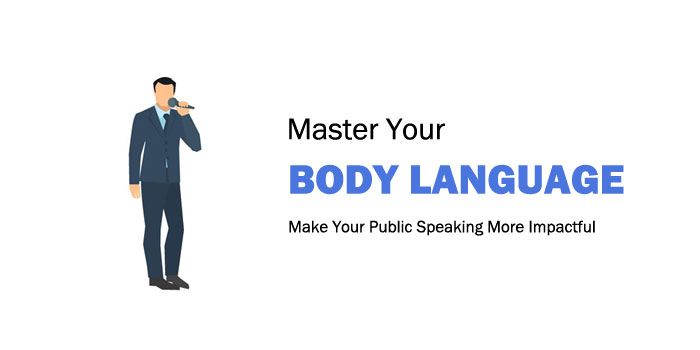
Public speaking can be daunting. Even seasoned speakers can sometimes lack confidence and poise in front of a crowd. Your words may be carefully constructed, but what about your body language? Are you making the best use of everything from your head tilt to your hand gestures to create the most impressionable, powerful performance? It can be hard to know where to start when it comes to improving your body language for public speaking. After all, there’s so much to take into account. Which can make you even more anxious! But never fear – in this blog post we’ll show you how to master your body language and make your public speaking more impactful. We’ll cover basics, like posture and facial expressions, to finer details, like microphone technique, to ensure you make the right impression every time. So let’s get started on taking your public speaking to the next level – the only way is up!
Quick Answer
Using body language when giving a speech or presentation can help to convey your message more effectively and engage the audience. Make sure to avoid any nervous habits such as fidgeting and maintain good posture. Use hand gestures and facial expressions sparingly and intentionally for maximum effect.
Understanding Body Language
Understanding body language is key for any public speaker to be successful in creating an impact. On one hand, researchers suggest that body language can provide insight into a person’s true feelings, intentions and thoughts.
Whether it be positive reinforcement like a thumbs-up or negative reinforcement like facial expressions of frustration - body language always plays an important role in the understanding of communication.
Additionally, during the speaking portion of a presentation, a speaker’s posture will affect their delivery, giving off strong signals of confidence and power when done correctly. On the other hand, many people have studied nonverbal communication and report mixed findings on its accuracy.

Our own biases as individuals tend to influence our interpretation of what we observe in another’s body language. Context can also play a big role in how we interpret cues - something that someone may consider as confident body language could easily be considered intimidating or aggressive depending on the scenario and the audience it is being given to. Overall, understanding the basics of both verbal and nonverbal communication is essential for any successful public speaker to make an impactful statement. By understanding these essential differences between each form of speaking, a speaker can craft their presentation accurately and congruently in order to achieve their desired outcome. Now that an understanding of body language has been discussed, the following section will discuss "What is Body Language" in further detail.
Must-Know Summary Points
Body language, both positive and negative, plays an important role in communication. Body language can influence how successful a public speaker is, as their posture not only affects delivery but also signals confidence and power.
The interpretation of nonverbal communication, however, can be affected by the individual's biases and context-dependent cues. To make a successful impact through speaking publicly, one must understand both verbal and nonverbal forms of communication.
What is Body Language?
Body language is a form of communication that uses nonverbal cues, such as posture, gestures, facial expressions, and eye contact to convey messages. It is defined as “ the behavior that one displays during communication through body movements, posture, and gestures .”

Body language can be used to express a variety of emotions, including happiness, anger, sadness, confusion, or surprise. It is also an effective way to make a point or emphasize something important when delivering a speech. Body language can be both beneficial and detrimental depending on the context in which it is used. For instance, standing up straight with your arms crossed applied can make you appear more authoritative or confident. On the other hand, this gesture may come off as aggressive and intimidating if the tone of your message isn't aligned with the assertive body language. By being mindful of our body posture and movements before and during a presentation we can ensure that the message we are trying to convey is accurately interpreted by our audience. With a better understanding of how body language affects public speaking, we can use it to our advantage and create meaningful connections that foster trust and respect with our audience. In the next section we will explore how to use body language to make your public speaking more impactful.
The Impact of Body Language
When it comes to public speaking, what we say matters, but the way we say it matters even more. Body language is a universal language and can have an immense impact on how your message is received by an audience. Often times, before you have even said your first word, your body language has already spoken thousands of words to the audience. The lines of your face, curve of your throat, folds in your clothing and the look in your eye all speak volumes about how you are feeling and what kind of attitude you bring to the podium. For example, if a speaker appears tense or closed-off, it may cause some audience members to become defensive or uncomfortable. But if a speaker comes across as open and confident, it helps put the audience at ease and encourages them to respond positively to what they hear. Body language can also have numerous other nonverbal communication benefits during public speaking . For example, well-timed pauses , emphasis on certain points through gestures, and capturing attention with eye contact can all help take an average speech and turn it into something that really resonates with the listener. On the other hand, there’s no denying that people’s perception of body language can be highly subjective. While certain body language cues such as crossed arms may be indicative of being closed off to ideas that don't align with one’s own beliefs for some people, for others crossed arms may simply mean deep concentration.

So its important to keep in mind that how we interpret someone else’s body language largely reflects our own preconceived notions rather than calling out any specific trait of another person. The impact of body language when giving a public presentation should not be underestimated - it can turn a mediocre performance into something extraordinary by creating a connection with listeners and keeping them engaged throughout. Now let's take a closer look at how you can use body language effectively during public speaking to maximize this impact.
Body Language During Public Speaking
Body language during public speaking can have a huge influence on the delivery of your speech, as well as your overall success. The way you move and use your body to convey your message is one of the most important elements of delivering an effective presentation . Your body language can reveal how confident or hesitant you are about the material you’re conveying and how engaged or disinterested your audience is. When speaking in front of people, maintaining an open body language can demonstrate your confidence and help put them at ease. Some people tend to cross their arms when they become nervous , which can come off as confrontational or even hostile.

Your posture should be relaxed but upright—avoid slouching or hunching over, as this comes off as unprofessional and may signal a lack of confidence in yourself and your message. On the other hand, standing too straight and rigid can also be intimidating. Standing with your feet slightly apart in an open stance conveys openness and comfort with yourself and your message. Your facial expressions should also match what you’re saying—a grimace when telling a funny story, for example, is confusing for the audience. It’s important to stay aware of flinching or winking too much, which can make it seem like you’re not paying attention to what you’re saying or are uncomfortable with the content. Make sure to look out for any unintentional visual cues that might distract or confuse your audience. Keeping good posture and making sure your movements coincide with the flow of your speech will enable you to project confidence and enthusiasm that will keep your audience engaged throughout the duration of your presentation.
Your facial expressions play an equally vital role in helping you get your point across efficiently so it’s important to become aware of them while speaking. With greater awareness and practice, mastering nonverbal communication during public speaking will become easier and more natural. Next we will discuss how facial expressions and posture play key roles in how impactful a speaker is during public presentations.
Facial Expressions and Posture
The way we use facial expressions and posture when speaking publicly has a huge influence on how people perceive us. Our eyes, forehead, mouth, and chin all send organic cues to others about our feelings and thoughts.
It’s important to pay attention to the signals our faces are sending, making sure they are intentional rather than merely fleeting. Additionally, our posture speaks volumes when it comes to communicating with an audience. One of the most important gestures that can help you connect with your audience is smiling. A charming smile can boost credibility, increase positive reactions, and help keep the atmosphere light-hearted.

On the other hand, the opposite can also be true: frowning and furrowing your eyebrows may distract or upset a room of listeners. So practice your presentation with a big smile and choose wisely when changing expressions during your speech. In addition to facial expression, posture is essential in public speaking. Standing up straight and tall projects strength and authority while slouching signals weakness and uncertainty. By standing up with proper posture while speaking publicly you give off an impression of capability and confidence, which will make people better listen to what you have to say.
For example, when talking to an audience try planting your feet hip-width apart; this will ground yourself in your message. Slumping or swaying back-and-forth sends a negative message about self-belief that your audience can sense subconsciously; so pay attention to subtle adjustments that express dedication and seriousness for your speech topic . Overall, facial expressions and posture play an integral role in public speaking as they set up tangible associations with the message one is trying to communicate as a speaker or presenter. Next up in this article we will discuss practical tips for utilizing body language during public speaking.
Tips for Using Body Language in Public Speaking
When preparing to give a public speech , body language plays an essential role in connecting with and impressing your audience. It can be used to emphasize key points and create the kind of lasting impression you want to make. Here are some tips for using body language effectively: 1. Stand Confidently – A confident posture expresses power, passion, and conviction. Keep your hands at your sides instead of crossed over your chest as this has been shown to make people appear more defensive and tense. Make sure your body weight is well-distributed by standing with both feet firmly planted on the ground. 2. Don’t Fidget – People tend to fidget when nervous and this can be distracting or even annoying to an audience. To combat this, practice presenting in front of a mirror so that you can become familiar with how you move and where you may need to adjust. 3. Use Intentional Gestures – If done properly, gestures can help add energy and excitement to an otherwise dull presentation. Avoid robotic gestures that don’t mean anything; practice deliberate gestures that connect with the topic or point you are making in meaningful ways for maximum impact. 4. Make Eye Contact – People love it when presenters look them directly in the eye because it makes them feel included in the action, connected to their speakers, and more likely to remember what was spoken about. Aim for 3-5 seconds of direct eye contact with each person who is listening so that you communicate strong, vibrant energy throughout the room. By taking advantage of these speaking techniques and using meaningful gestures, powerful stances, and confident looks, you will have presented a far more impactful speech than had any of these body language methods been overlooked or neglected. Now, let's talk about common mistakes to avoid when delivering public speeches...
- Research studies show that a speaker's body language accounts for up to 93% of their communication when presenting (although this may not be true).
- Effective body language can help to create rapport between the presenter and the audience, leading to more effective communication
- Studies have shown that positive body language, such as open and inviting gestures, can help increase audience engagement and understanding of the message.
Common Mistakes to Avoid
Public speaking is a challenging endeavor, and even seasoned presenters can make mistakes. It can be easy to forget about the need for attentive body language if you get too caught up in your presentation. To mitigate the possibility of ‘faux pas’, it is important to understand some common blunders that can lessen the impact of your performance. It is vital to avoid maintaining an unfavorable facial expression; for instance, scowling or yawning. Such expressions tend to leave negative impressions, making it difficult to maintain attention. Instead, try to adopt a relaxed and pleasant facial expression which will help put people at ease and keep them engaged.

Your posture is another essential aspect of body language. Don’t slouch or hunch your shoulders as this position communicates a lack of confidence or enthusiasm and disengages the audience. Aim to stand with even proportions; your feet shoulder-width apart with your chest held up and arms loose by your side. This establishes a stance that suggests dynamism, engagement, and assurance - words you want associated with yourself and your speech. On the other hand, it is also important not to contort yourself into an over-assertive pose that may distract from the content of your address. Many speakers adopt hyperextended poses such as spreading their arms wide and pacing back-and-forth across the stage setting their audience on edge rather than inspiring them with confidence in the speaker’s message. In conclusion, practice mindful body language when speaking publicly: maintain a friendly expression, appropriate posture, and avoid gestures that detract from what matters most -your presentation content! Building self-confidence to ensure successful public speaking requires both clever content delivery and skillful manipulation of body language – something we will explore further in the following section on building self-confidence while speaking publicly.
Building Your Self-Confidence
Confidence is the cornerstone of public speaking. It is essential for conveying effective messages and connecting with your audience. Building up your self-confidence before a speech or presentation will ensure that you are ready to deliver an impactful performance. Here are some strategic tips for increasing your self-confidence when you take the stage: 1. Practice, practice, practice – Before delivering a speech, engaging in multiple rehearsals helps individuals become more familiar and comfortable with their material. Rehearsing enables speakers to focus on specific points of their speech and practice the flow and delivery of their words with precision.
Additionally, rehearsing also provides an opportunity to perfect and enhance content that can potentially elevate the level of enthusiasm within your audience. 2. Boost your posture – Holding yourself in a “power pose” can be an effective way to channel confidence both onstage and offstage. Highlighting important moments with dramatic gesture indicates a grounded, passionate presence that leaves a lasting impression on viewers.
When people feel as if they can trust and respect who is communicating a message, it increases engagement and creates opportunities to further dialogue or discussion afterwards. 3. Set attainable goals – Curating manageable objectives for yourself is another great way to build self-confidence before going on stage. This includes building out an agenda (also known as ‘ speaker notes ’) that lays out talking points and bullets important sections of your presentation beforehand so that you can confidently navigate transitions between slides or topics during delivery.
Setting clear expectations beforehand not only reminds the speaker what topics are of importance, but it also offers direction so speaking becomes easier when conducting research or writing scripts ahead of time.
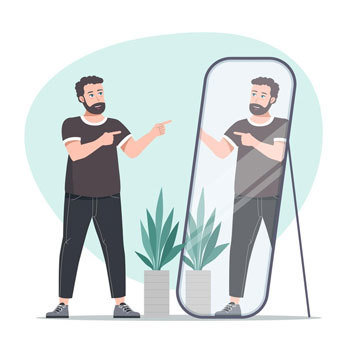
4. Visualize success – Visualization is another form of preparation that can have significant effects on one’s self-confidence levels prior to taking the stage. It involves creating vivid mental images related to successful performance while simultaneously reminding oneself that they have successfully conquered other speaking engagements prior preceding this one; this essentially helps make it easier transitioning from anxiousness into preparedness pre-speech day nerves. Confidence can be seen as both an intrinsic quality associated with personality traits such as charisma, charm, poise and eloquence, as well as something environmental or situational like body language, external feedback or attitude surrounding a particular event or task at hand that contributes to overall comfortability levels onstage (or offstage).
Consequently it can be argued that one needs both external factors working in tandem with personality attributes to establish robust personal confidence capable of maximizing success onstage as a public speaker; however where people depict various levels of comfortability with how each contributes towards self-efficacy depends largely upon individual beliefs about their own character and abilities involving communication(s).
Ultimately, developing strategies for harnessing confidence for public speaking requires individuals to assess what works best for them based upon what makes them feel most prepared & competent when under pressure - that’s why it’s important to review all available options prior developing tactical plans designed to elevate public speaking performances; good luck!
Most Common Questions
How does body language emphasize content when public speaking.
Body language is an important factor when it comes to emphasizing content when public speaking. This is because people tend to take in nonverbal cues more than verbal cues. S
tudies have shown that 93% of communication is nonverbal, which means that what you do with your body language can be just as influential as the words you use.
When delivering a presentation or speech, gestures and movements can be used to emphasize key points, draw attention to certain ideas, and add depth and meaning to the content.
For example, making large hand gestures when discussing a significant idea helps communicate a powerful message, while pointing at relevant diagrams or visuals helps guide the audience’s attention toward important information.
Additionally, maintaining strong and confident posture while speaking also sends a signal of authority and helps engage listeners. Ultimately, by deliberately incorporating body language into presentations or speeches, presenters can effectively emphasize the content being presented and increase its impact on audiences.
What are some common mistakes to avoid with body language in public speaking?
One of the most common mistakes to avoid with body language in public speaking is not maintaining good posture. Keeping your head up and shoulders back shows confidence. Avoid slouching, which can make you appear uncomfortable or insecure.
Additionally, avoid excessive movements such as fidgeting, gesturing too much or rocking back and forth. These habits can be distracting to your audience and detract from the message that you are trying to get across. Another mistake to avoid is using negative gestures and facial expressions. Too many negative expressions like frowns or eyerolls can provide a conflicting message to your audience, weakening the impact of your words.
As a speaker, it’s important to project confidence, so negative body language can be counter-productive. Smiling or looking positive while speaking will give off a confident air and help keep the atmosphere positive and engaging. Finally, be aware of how much space you are taking up and remain conscious of what your body is saying. Invading too much personal space makes people in the audience feel uncomfortable.
Be sure to match people’s body language cues so that it doesn’t come off as aggressive or intimidating. By paying attention to these small nuances, you will be able to properly control your body language in public speaking and make a bigger impression on your audience!
What are the most important tips for using body language in public speaking?
The most important tips for using body language in public speaking are: 1. Establish good eye contact - to your audience, look around the room and make sure to engage people with eye contact at different points while you speak. 2. Use open body language - avoid postures that suggest discomfort or lack of confidence such as crossed arms, fidgeting, and avoiding direct eye contact. Instead, strive to use body language that suggests openness and comfort. 3. Use gestures to emphasize points - gestures can help engage your audience, amplify the message you're trying to get across, and give energy to your presentation. Practice beforehand what gestures will help accentuate each point in your presentation and use them appropriately when speaking. 4. Use facial expressions - don't just stand still like a statue! Make sure to smile, frown, use surprise and other subtle expressions as appropriate to convey emotion with your words and make your story come alive for the audience. 5. Vary Your Speech Pace & Volume - vary the speed of your delivery based on the content of your speech and don't forget about pushing up or down on the volume of your voice for multi-syllable words or when emphasizing a point – movement of your hands can be helpful too! Using these tips during public speaking can help make it more impactful and have better results in conveying your message across effectively to any audience.

Seven Top Body Language Tips for Better Presentations [2023]
November 29, 2023
Better Body Language is a Key Presentation Skill
You can use positive body language to enhance your presentations. body language can be a powerful tool to engage your audience, demonstrate gravitas and deliver a more impactful presentation., developing good body language for presentations is a real skill. and it’s a skill you can improve. over the last 15 years we’ve coached thousands of people to be comfortable and successful. if you need help, do please get in touch. we run in-house and online coaching sessions for business executives. it’s fast and good value., our presentation experts have put together a list of great body language tips you can use to improve your next presentation. and we’ve gathered some videos so you can see these body language tips in action., here is a quick guide to good body language and how to use it when presenting:.
Improve your presentation body language – top tips Use your body language to show confidence Use your hands to emphasize points Make eye contact Use your facial expressions to show emotion Use your body movement to add energy Beyond body language: use props effectively Practise good body language and stage presence
1. Use your body language to show confidence
Stand up straight with your feet shoulder-width apart, and make sure your body is facing the audience. This will help you project confidence and command attention. Avoid crossing your arms, as this can make you seem closed off or defensive. Keep the bottom half of your body relatively still and put all your movement in the top half of your body.
2. Use your hands to emphasize points
Our clients frequently ask “What should I do with my hands?”.
Hand gestures are best used to emphasise key points. They also add energy to your presentation, particularly when you use them above shoulder-height. Jill Bolte’s TED talk demonstrates this well. Too much movement can be distracting, however. Lots of tiny movements or flapping your arms around makes you look smaller and unconfident. Go for big, bold, purposeful gestures that you hold for a few seconds. These convey presence, leadership and authority.
![Seven Top Body Language Tips for Better Presentations [2023] 1 YouTube player](https://i.ytimg.com/vi/UyyjU8fzEYU/maxresdefault.jpg)
When you aren’t using your hands to emphasise what you’re saying, hold your hands slightly in front of you, with bent elbows. That’s what good body language looks like. You may find this feels odd at first – but watch Ken Robinson to see how effective it can be. If you are using a lectern, then above-shoulder gestures will be the only ones your audience can see. If you choose to rest your hands on the lectern, keep them hands loose and relaxed. Avoid looking as though you are hanging on for dear life!
![Seven Top Body Language Tips for Better Presentations [2023] 2 YouTube player](https://i.ytimg.com/vi/wX78iKhInsc/maxresdefault.jpg)
3. Make eye contact
Making eye contact with your audience helps establish a connection and shows that you are confident and engaged. To use your body language most effectively try to make eye contact with different people throughout the room, rather than just focusing on one person.
What would you think if I didn’t look you in the eye?
Or if I avoided your gaze? Or if I looked down every time I said something? What impression do you get?
You need good eye contact to be a good presenter..
We like people who can make eye contact (remember the last time you were flirting with someone?). We trust people who can “look you in the eye” . We want to see people “ eye-to-eye “.
When presenting or speaking in public you will get a better reaction if you improve your eye contact. Eye contact is a learned skill that takes practice. From extensive work with our clients, here are some easy tips you can apply for powerful eye contact:
- Only talk when you are looking at someone. No more looking into your notes or staring into the middle distance.
- Spend one or two sentences talking to each person. Get some ‘quality time’ with each person.
- Hold your eye contact until the end of the sentence.
- If you are nervous, if you don’t like looking into someone’s eyes, then look at their forehead or nose.
- Practice improving your eye contact. Start with friends. Make them point out each time your eye contact drops.
Just these simple tips for powerful eye contact will make you a more convincing and persuasive public speaker.
This is such a simple body language trick. Many people underestimated how powerful it is.
4. use your facial expressions to show emotion.
Your facial expressions can convey a lot of emotion and help engage your audience. Good body language means using facial expressions to show enthusiasm, concern, or surprise, depending on the content of your presentation.
5. Use your body movement to add energy
Adding some movement to your presentation can help keep the audience engaged and add energy to your delivery. Good body language can be as simple as taking a step forward or backward when making a point, or using your hands to gesture.
As with hand gestures, deliberate movements that emphasise your content work well. But too much movement is distracting. Getting the balance right takes practice.
Aim to stand still for the majority of your talk. This will convey confidence and authority. Plan in advance when you will move, combing those movements with breaks in your content. Express a full thought or point in your new position before moving again. Avoid pacing, which makes a speaker look distressed. Make a point, move to another part of the space and make your next point. Aim to emulate a pleasant countryside walk from viewpoint to viewpoint, rather than a nervous wait outside a labour ward!
Contact us for a free consultation on your coaching needs
6. Beyond positive body language: use props effectively
Props can be a great way to add interest to your presentation and help illustrate your points. However, be sure to use props sparingly, as too many can be distracting.
7. Practise good body language and stage presence
Your stage presence, or the way you move and present yourself on stage, can greatly impact the effectiveness of your presentation. Practise your stage presence by rehearsing in front of a mirror, or by recording yourself and watching the footage. This will help you avoid any negative body language.
By using body language effectively during your presentations, you can engage your audience and deliver a more impactful message. Remember to pay attention to your posture, hand gestures, eye contact, facial expressions, body movement, and stage presence, and practice using these techniques to enhance your presentations.
As soon as we become conscious of our bodies, they get in our way. When we’re faced with an audience, we become like learner drivers, frozen and unnatural. Advice to ‘act naturally’ isn’t useful, as being watched isn’t natural. Besides, communicating to an audience requires different body language than everyday, one-to-one communication.
Your body language matters when presenting.
We’ve all seen powerful speakers, whether in person or on platforms such as TED.com. We use words like ‘charisma’ and ‘presence’ to describe impressive speakers. But some speakers are uncomfortable to watch. Others use such distracting body language that we cannot focus on what they are saying.
Good body language with strong, positive non-verbal communication can be more powerful. Here, we share our top tips for best use of your hands, eye contact and on-stage movement.
These top tips will help you improve your body language when presenting.
- Take control of your body language
- Ignore ‘Just act natural’ advice
- Get feedback and increase your body language self-awareness
- Establish good eye contact
- Use your hands when presenting
- Command the space where you are speaking
- Start with good content in your presentation
Remember, for Effective Body Language, Take control
Non-verbal communication has three uses , according to David Lambert.
replace speech (e.g. a wink)
Reinforce speech (e.g. nodding while saying ‘yes’) a, give clues about our true feelings (e.g. fidgeting when nervous)..
Successful speakers use open, controlled and strong gestures that reinforce their message . Less successful speakers contradict what they say with their non-verbal behaviour.
For instance, if your body language suggests nervousness when you speak, the audience will interpret this as a lack of confidence in your own message. Equally, if you fold your arms while you speak, you create an implied barrier between you and your audience. That’s why successful leaders learn how to control their posture and gestures to avoid negative or distracting body language.
Better Body Language: Just acting ‘naturally’ doesn’t work
Speaking to large groups of people isn’t a natural situation, so aiming to behave ‘naturally’ is an unhelpful goal. In fact, to transfer energy and enthusiasm to your audience, you need to be ‘more’ than you would normally be in smaller-scale interactions.
For example, to be impressive when presenting you need to be more expressive and more powerful in your command of space.
Positive Body Language: Increase your self awareness
At Benjamin Ball Associates, we film our clients during our coaching sessions. When they watch the footage, they are often surprised to see their body language contradicting their message.
For example, one speaker subtly shook his head in a ‘no’ gesture’ when he was answering ‘yes’ to a question. For a low-tech alternative, try delivering your talk in front of a mirror or recording yourself on a phone. Learning how to watch yourself and improve from self-analysis is key.
A better presentation is the first step to better delivery
If your presentation is weak, even the best body language will leave audiences unmoved. Conversely, the better your presentation, the more confident you’ll feel about delivering it. You’ll find that your body language naturally improves once you feel confident and comfortable about your presentation.
That’s why we focus on getting that right first. In our presentation coaching We:
- Ensure you have a clear message
- Create a subtle structure that gently guides your audience
- Strengthen the language you use, so it is more powerful.
- Refine the start of your talk and end of your presentation until they produce maximum impact.
Then you’ll find polishing your body language much easier.
Start Improving My Body Language Today
Start your journey to world-class public speaking skills now
First, download our free ebook to start your journey towards becoming a Powerful Presenter.
You’ll learn our 5-step process for transforming dull, forgettable and un-engaging presentations into your most Powerful Presentations yet: inspirational, memorable and persuasive.
It’s full of practical tips and insightful quotes that will help you make immediate improvements to your leadership talks and presentations, including:
- Increased confidence when you talk and present.
- Improved ability to persuade your audience.
- Greater engagement with your audience.
- Practical ways to plan and structure your talks.
- The inspiration and motivation to change.
Download your free copy of our Five Steps to Transform your Leadership Talks ebook now.
Get expert support
We can support you with all aspects of your talk. Not just body language, but also the content of your presentation, your voice and everything else that will make you a successful presenter.
Over 15+ years our award-winning team has helped hundreds of CEOs and senior executives deliver impressive and persuasive talks, speeches and presentations.
We can transform your presenting skills and your body language in as little as a few hours.
Call Louise on +44 20 7018 0922 or email [email protected] to find out more.
Transform your presentation skills with tailored coaching
![Seven Top Body Language Tips for Better Presentations [2023] 3 Benjamin Ball Associates Presentation skills coaching team](https://benjaminball.com/wp-content/uploads/2024/01/BenBall_group2_colour-1024x349.jpg)
We can help you present brilliantly. Thousands of people have benefitted from our tailored in-house coaching and advice – and we can help you too .
“I honestly thought it was the most valuable 3 hours I’ve spent with anyone in a long time.” Mick May, CEO, Blue Sky
For 15+ years we’ve been the trusted choice of leading businesses and executives throughout the UK, Europe and the Middle East to improve presentation skills and presentations through coaching, training and expert advice.
Unlock your full potential and take your presentations to the next level with Benjamin Ball Associates.
Speak to Louise on +44 20 7018 0922 or email [email protected] to find out more and discuss transforming your speeches, pitches and presentations.
Or read another article..., how to create a winning elevator pitch – top 11 tips.
If you need to give a short pitch – an elevator pitch –…
Strengthen Your Leadership: 9 Top Management Training Courses in Communication
If you are a business manager, effective communication skills are central to being…
How to Sell your Business: 9 Success Secrets
Get the best value when you sell your company Embarking on the journey…
How to Present Confidently- 14 Step Guide [2024 update]
How to banish your fear of public speaking and become a confident presenter…
Contact us for a chat about how we can help you with your presenting.
What leaders say about Benjamin Ball Associates
Ceo, plunkett uk.
"Thank you so much for an absolutely brilliant session yesterday! It was exactly what we were hoping for, and you did an incredibly job covering such a range of issues with 4 very different people in such short a session. It really was fantastic - thank you!"
James Alcock, Chief Executive, Plunkett UK
Manager, ubs.
"Essential if you are going to be a spokesperson for your business"
Senior Analyst, Sloane Robinson
"Being an effective communicator is essential to get your stock ideas across. This course is exactly what's needed to help you do just that!"
CEO, Blast! Films
“Our investment in the coaching has paid for itself many times over.”
Ed Coulthard
Corporate finance house.
“You address 95% of the issues in a quarter of the time of your competitor.”
Partner International
“Good insight and a great toolbox to improve on my presentations and delivery of messages to not only boards, analysts and shareholders but to all audiences”
CEO, Eurocamp
“We had a good story to tell, but you helped us deliver it more coherently and more positively.”
Steve Whitfield
Ceo, ipso ventures.
“Ben did a great job on our presentation. He transformed an ordinary set of slides into a great presentation with a clear message. Would definitely use him again and recommend him highly.”
Nick Rogers
“Moved our presentation into a different league and undoubtedly improved the outcome and offer we received.”
Let's talk about your presentation training needs
+44 20 7018 0922, [email protected], our bespoke presentation coaching services, investor pitch coaching, executive presentation coaching, public speaking training, executive media training, new business pitch coaching, privacy overview.
ATLANTA, MAY 23-24 PUBLIC SPEAKING CLASS IS ALMOST FULL! RESERVE YOUR SPOT NOW

- Public Speaking Classes
- Corporate Presentation Training
- Online Public Speaking Course
- Northeast Region
- Midwest Region
- Southeast Region
- Central Region
- Western Region
- Presentation Skills
- 101 Public Speaking Tips
- Fear of Public Speaking
4 Tips For More Effective Body Language in Public Speaking

Body language in public speaking is the nonverbal cues that your movements make during communication. Presenters often focus on what they are going to say and their visual aids. However, we often overlook an important part of the speech — body language. Non-verbal communication makes a lasting impression and makes a marked difference in your communication skills. And when it comes to public speaking, if you look poised and confident, your audience will believe you are poised and confident.
In this session, we’ll cover a few simple public speaking ideas that will give you good posture and encourage better body movement. First, we show how important the power of body language is during your presentation. Next, I’ll give you a few, simple tips to look more confident and create a good impression (even if you’re nervous). Finally, I’ll share a presentation secret that, once you understand it, will change the way you look at your nervous habits forever (and in turn, help you give a great presentation).
You Body Language in Public Speaking is Important to a Successful Speech.
When presentation coaches reference body language, they often refer to a 1967 study published by Albert Mehrabian. Dr. Mehrabian is a professor at UCLA. His study showed that only 7% of communication comes from the words spoken. He said that 38% of communication comes from the voice and tone. The final 55% of the communication process comes from body language. In reality, this study has nothing to do with public speaking or presenting. So, the reference to the “Mehrabian Formula” as a reason to focus on body language in public speaking is false. However, that doesn’t mean the power of nonverbal communication isn’t important.
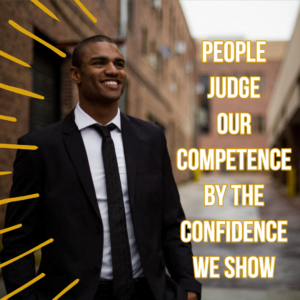
The better that a speaker carries himself or herself, the more credibility the speaker has with the group. If you look timid or nervous, your audience will question your competence. Confident body language has a profound effect on the unconscious mind of your audience. So much so that, even if they know you’re a new speaker, they won’t help but feel turned off by the small details, like a lack of good eye contact and other aspects of body language.
To cover for nervousness, a lot of speakers will avoid negative body language by hiding behind a lectern. Others will deliver their entire presentation from a seated position and make the slideshow the presentation. When you do these things, though, you are losing your connection to the audience. You are also, likely, inadvertently making your presentation more boring.
A Few Simple Presentation Tips to Improve Body Language
If you want to see your ability as a persuasive public speaker improve, try these simple tips. Just testing out one or two of them will show you the real impact of body language.
1. Set Your Screen to the Side, Not the Front
What? What does the screen’s placement in the room have to do with body language in public speaking? Well, everything. Many presenters will set the projection screen or digital screen in the very center of the room. When you do this, though, your ability to move around the room is significantly limited. You’re forced to work in a smaller “stage” to present from, and you’re now off to the side. Your audience didn’t come to see you click through bullet points. They came to hear you speak.
2. Take a Deep Breath and Drop Your Hands to Your Side.
Please don’t misunderstand this tip. The tip ISN’T to KEEP your hands by your side. It’s just the opposite. When you start your presentation with your hands dropped loosely by your side, your first gesture will be bigger and more powerful. This is a powerful tool you can try from wherever you are right now.
Stand up and clasp your hands together in front of your waist as most presenters do. Now, break the clasp and try to make a gesture with one of your hands. Try it a few times. When you do, you will notice that your elbow will tend to rest around your hip. The gesture will look robotic. If you alternate moving your hands from that clasped position, you will likely look like a t-rex. Fearless Presentations , I mentioned in the book that “People judge our competence by the confidence that we show.” This statement is so true.
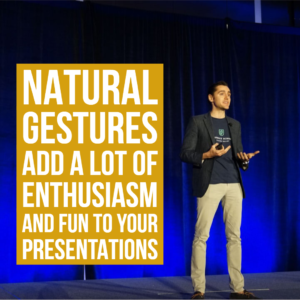
Now, drop both hands to your side and let them hand loosely. Try to make the same gesture that you did before. When you do, you will, most likely end up moving BOTH hands. This time, the gesture will look more powerful and energetic. Also, when you stop making the gesture, you will probably return your hands to your side so that your next gesture is also powerful. (Your hands will often return to their starting point.)
If you’re having trouble remembering to drop your hands to your side, try one of these 3 tips:
Incorporate Slow Breathing and a Relaxed Stance: Begin your presentation with slow breathing and a relaxed body language, keeping your hands at your sides. This not only calms your nerves but also sets a composed tone for your speech. A relaxed physical presence goes a long way in making your delivery appear confident and effortless. Remember, a calm demeanor and tone of voice can make a big difference in public speech.
Practice Purposeful Gestures and Open Palms: When rehearsing, focus on using your whole body to make purposeful and open gestures. An open palm can signal honesty and active participation from the audience. Treat this as a learned skill, where each movement, including returning your hands to your sides, is a part of your physical expression. This technique enhances audience engagement and ensures your gestures complement the tone of your voice.
Visual Cues and Physical Movements Checklist: Create a checklist of physical movements, including keeping your hands at your sides, which you can refer to as an exhaustive list during practice. This list can act as a reminder that each aspect of your body language, from your gestures to your posture, contributes to a great idea being effectively communicated. Regular practice with these visual cues helps in embedding these actions into your muscle memory, ensuring a more natural and engaging delivery.
3. Tell More Stories
If you want to have great body language when presenting, tell more stories. It is almost impossible to tell a story without using your hands to explain what is happening. For instance, when I start my presentation skills seminars , I will often start with a story. Typically, I tell the class what happened to me the first time I had to speak in front of a room of executives. As I describe how my hands got sweaty, I often naturally rub my palms on my pants. When I tell them how I zoomed through the presentation, I move my hands quickly in small circles. These movements add clarity to my description. No one ever taught me how to do this. These gestures happen naturally as I relive the incident from memory.
These natural gestures add a lot of enthusiasm and fun to your presentations. So, if you want to use more poised body language, tell more stories.
Here are some additional tips on incorporating gestures into your presentation:
Mimic the Action : When narrating an event or action in your story, mimic the movement with your hands or body. For example, if you’re talking about opening a door to a new opportunity, physically mimic the action of turning a door handle and pushing a door open. This not only makes your story more vivid and engaging but also helps the audience visualize the scenario better.
Use Symbolic Gestures : Incorporate gestures that symbolize concepts or emotions in your story. If you’re discussing overcoming obstacles, you might show pushing against an invisible barrier with your hands. For stories involving growth or progression, use upward or forward-moving hand motions. These symbolic gestures can powerfully convey abstract ideas and emotions, enhancing the impact of your story.
Avoid Overuse of Gestures : While gestures can greatly enhance your storytelling, it’s important to use them judiciously. Be mindful not to overcrowd your narrative with excessive or exaggerated gestures, as this can distract or even confuse the audience. The key is to ensure that your gestures feel natural and spontaneous, complementing rather than dominating the story. Let your movements flow organically from the narrative; if a gesture doesn’t feel natural or necessary, it’s often better to omit it. This approach maintains the authenticity and impact of your storytelling.
4. Use Your Visual Aid
One of the things that bug me most is when a speaker stands (or sits) clicking a clicker. If you are going to take the time to create a great slide or visual aid… USE IT! One of the techniques that we cover in our speaking class is to visually touch your slide. I know it sounds weird, but it works like magic.
Have you ever been in a presentation where a speaker puts up a series of bullet points and just starts talking? As he presents, you may think he is on point four, but then he clicks to the next slide. This occurs because the speaker naturally assumes that you can figure out which point he is on. As a result, he doesn’t both to tell you when he moves from one point to the next. In most cases, the points aren’t clearly defined, anyway, so there is a lot of overlap. This makes the entire presentation confusing.
A better way is to physically go to the screen and point to bullet #2 when you move to bullet #2. If you combine this technique with telling a story, your presentation comes alive. This happens because the speaker will move toward the screen to identify the next point. Then, she will jump into an example or story to clarify the point. She will naturally move back toward the audience as she tells the story. Of course, as she tells the story, she will use those natural gestures as well. This combination of techniques adds a lot of enthusiasm and energy to a presentation.
A Presentation Secret that Should Help with Presentation Gestures
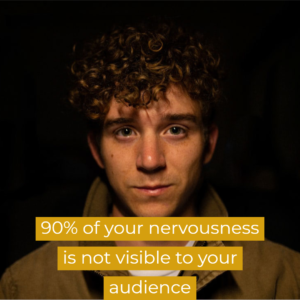
In reality, most speakers feel nervousness. It is just that most of the symptoms they feel aren’t visible either. If you understand this and use a few of the tips we covered earlier, you can look very poised when you speak. (Even if you are nervous!)

Free Public Speaking Tips , Podcasts
View More Posts By Category: Free Public Speaking Tips | leadership tips | Online Courses | Past Fearless Presentations ® Classes | Podcasts | presentation skills | Uncategorized
Like what you're reading?
The mastery of body language for a presentations
Get your team on prezi – watch this on demand video.
Anete Ezera November 24, 2023
We know that creating a stunning presentation isn’t enough to fully sway your audience. When you take the stage for that all-important Prezi presentation, your words matter—but your body speaks volumes. The subtle tilt of the head, the grounding of your stance, and the assured gesture of your hands; are the unspoken elements of dialogue that can captivate an audience before you even utter a word. Fortunately, with a Prezi presentation, you already set the stage for confident delivery, captivating your audience from the first few seconds and providing the confidence boost you need. However, how you end up delivering your presentation using the tone of your voice, posture, movement, and gestures, is up to you. That’s why in this article, we’ll equip you with the skills to ensure that your actions speak as confidently as your words and Prezi presentation.

The power of body language in presentation
The silent language of our posture, gestures, and facial expressions speaks volumes about our confidence. In a presentation, the audience is not only listening—they’re also observing. Effective body language for a presentation can reinforce and amplify your spoken message, while poor body language can undermine it. When used adeptly, it serves as a powerful tool to engage your audience, convey authority, and leave a lasting impression.
Studies suggest that communication is only 7% verbal and 93% non-verbal, of which body language is a significant component. This emphasizes the critical role of physical expression in delivering a message. Therefore, understanding the nuances of body language for a presentation is not just beneficial—it’s imperative.
The basics of confident body language for a presentation
Starting with the basics, confident body language is the foundation upon which a successful presentation is built. Here are some tips about body language for a presentation that can set the stage for a powerful performance:
Posture: Stand tall with your shoulders back and chin up. This conveys confidence and helps you breathe better, thus improving your vocal projection.
Eye contact: Maintain a steady gaze with your audience. This builds trust and shows you’re engaged with them.
Gestures: Use your hands to emphasize points but keep them controlled. Avoid fidgeting, which can be distracting.
Movement: Move purposefully around the stage to engage with different parts of your audience but avoid pacing aimlessly.
Facial expressions: Smile where appropriate and match your expressions to your content to show passion and sincerity.
By integrating these body language basics into your presentation, you can start to harness the full potential of your physical presence.

Advanced techniques for body language
Beyond the fundamentals, there are advanced body language techniques that can help you connect with your audience on a deeper level:
Mirroring: When a speaker mirrors the body language of the audience, it can foster a subconscious bond, making the audience feel understood and connected. This mimicry can make the audience more open and amenable to the speaker’s message. It’s a psychological strategy that, when done subtly, can lead to increased trust and affinity, which is especially beneficial during persuasive speeches or when trying to establish common ground.
Staging: Deliberate use of space, such as moving towards the audience, can signal engagement and invite participation, making the presentation feel more interactive and personal. Conversely, stepping back can signal to the audience that it’s time to ponder a point you’ve made, providing them with a moment to absorb information. Effective staging can thus control the rhythm and emphasis of the presentation, making it more dynamic and memorable.
Variation in gestures: Utilizing a range of gestures can cater to different learning styles within the audience, as some people are more responsive to visual cues. Open gestures are generally perceived as welcoming and honest, which can help to create a positive atmosphere. In contrast, precise gestures, like pointing or enumerating points on fingers, can highlight key information and signal to the audience that something is of particular importance. This variety prevents monotony, keeps the audience’s attention, and underscores the speaker’s message.
Incorporating these techniques requires practice, but when done correctly, they can significantly enhance the effectiveness of your presentation. You can also explore our article on the 9 secrets of confident body language to get even more tips and insights on effective body language for a presentation.
Examples of well-mastered body language for a presentation
Ted presenters.
To illustrate these body language techniques, consider the demeanor of accomplished public speakers like TED presenters. They often begin their talks with a story or anecdote, using expressive hand gestures that match the emotional tone of their story. As the narrative builds, their movements around the stage draw the audience along on the journey. The strategic use of pauses, combined with sustained eye contact, allows the speaker to connect with the audience on a personal level, making the presentation more memorable. Discover more TED Talk presentation skills by watching the following video.
Lecturers and educators
In educational settings, teachers and lecturers use body language for a presentation to emphasize points and show enthusiasm for the topic. They might walk across the room to engage different parts of the audience or use hand gestures that correspond with key points on their Prezi slides. This helps students to connect visual information with physical actions, enhancing memory and understanding.
Salespeople
In sales pitches, effective body language is the silent ally of the salesperson. They use a confident posture to project assurance in the product they’re selling. Strategic use of hand gestures can draw attention to specific benefits or data on the screen, and making eye contact with various members of the audience helps to personalize the pitch and keep potential clients engaged.
Public speakers
Politicians and public speakers are also masters of body language for a presentation. They use their hands to emphasize conviction and make their points more compelling. They might step closer to the audience when sharing a personal story, using proximity to create a sense of intimacy. On the other hand, when they want to appear authoritative on a subject, they might stand tall, with hands behind their back, to command the room.

Exercises to improve body language during presentation
Before stepping onto the stage, it’s beneficial to engage in exercises that fine-tune your body language for a presentation:
Warm-up: Engaging in a physical warm-up before a presentation can be tremendously beneficial. It helps in reducing physical tension, which can otherwise lead to restrictive body language. A relaxed body allows for more fluid and natural movements, making the speaker appear more confident and at ease. Additionally, warming up can help regulate breathing, leading to better voice control during the speech.
Practice in a mirror: Practicing in front of a mirror allows presenters to become more conscious of their body language, including facial expressions and movements. This self-observation can help in identifying and correcting any behaviors that might be distracting or detracting from the message, such as unnecessary hand fidgeting or lack of eye contact.
Record and review: Recording practice sessions provide the opportunity to review one’s performance from an outsider’s perspective. It allows presenters to notice nuances in their body language that they might not catch in a mirror, such as the timing of gestures or the consistency of eye contact. This can lead to a more polished and professional presentation style.
Feedback loop: Constructive feedback from peers can offer a fresh perspective on a presenter’s body language. Colleagues may notice things the presenter doesn’t and can offer suggestions for improvement. This external input is critical for growth, as it can identify blind spots in a presenter’s self-perception and help refine their non-verbal communication skills.
By regularly performing these exercises, you can become more attuned to your body language for a presentation and gradually improve your non-verbal communication skills. Furthermore, discover other ways to improve your delivery skills according to your unique presentation style by watching the following video.
Body language pitfalls to avoid
Even seasoned speakers can fall into body language traps that detract from their message. Being aware of these pitfalls is the first step to avoiding them:
Over-gesticulating: While hand movements can be engaging, too much can be distracting. Aim for purposeful gestures that complement your words.
Lack of expression: A monotone delivery can bore the audience. Your facial expressions should reflect the passion and intensity of your message.
Closed posture: Crossing arms or legs can appear defensive. Aim for an open posture to seem approachable and confident.
Inconsistency: When your words say one thing but your body says another, it creates dissonance. Strive for consistency between your verbal and non-verbal cues.
Avoiding these common mistakes can help ensure that your body language for a presentation remains an asset, not a liability, during presenting.
The role of body language in audience engagement
The ultimate goal of your presentation is to engage your audience, and your body language is a key factor in achieving this. By leveraging positive body language for a presentation, you can:
When you step onto the stage, your aim is to not just present but to resonate with the audience. Non-verbal cues, like a warm smile or an open stance, can act as a conduit, establishing a rapport that transcends words. It’s this connection that can transform a room of passive listeners into a captivated audience. This silent dialogue fosters a sense of familiarity, making your message not just heard, but felt and experienced.
Your body speaks the language of conviction. When your posture is commanding and your gestures are assured, your words carry weight. Confidence emanates from the way you hold yourself, the assurance with which you move. It’s a subtle but powerful tool in your arsenal, lending credence to your arguments and swaying your audience with the unspoken but clear belief in your message.
Hold attention
In the ebb and flow of a presentation, your body language is the visual rhythm that keeps the narrative alive. Varied and dynamic body language acts as visual punctuation, highlighting key points and maintaining the narrative’s momentum. It breaks the monotony, adds emphasis where needed, and keeps the audience engaged not just with their ears, but with their eyes as well. It’s the difference between a monologue and a performance.

Remember, engaging body language for a presentation is not just about entertaining your audience; it’s about bringing them into your narrative, making them feel involved and invested in your message.
Incorporating technology and body language for a presentation
In today’s digital age, many presentations are enhanced with technological aids. How you interact with these tools can affect your body language:
Remote clickers
Use tools like clickers to advance slides seamlessly without interrupting your flow. When the flow of your presentation is interrupted, it not only wastes time but could also divert your audience’s attention from your message. If you’re a particularly nervous presenter, interrupting your flow could cause anxiety to kick in which is why it’s so important to practice with technology beforehand.
Tablets and screens
Engage with touchscreens naturally without letting them become a barrier between you and the audience. Physical barriers can disrupt the audience’s visual connection to you and your message, which can become a big distraction. Practice using tablets and screens throughout your presentation until it feels like second nature.
Virtual presentations
Even when presenting virtually, maintain an awareness of how your body language translates through the camera. It’s important to make sure you position yourself accordingly for your presentation. You want the audience to be able to see you clearly, with enough space for your hand gestures to be visible on the screen. With Prezi Video functionality, you can easily present your content right next to you on-screen, without needing to hide behind your slides, making your virtual presentations significantly more engaging.

In all cases, your interaction with technology should be smooth and practiced, ensuring that it supports rather than hinders your body language cues.
Mastering the silent dialogue: the final word on body language for a presentation
To convey your message with the utmost impact, aligning your spoken words with the unspoken power of body language is essential. By mastering confident body language for a presentation, you can transform it into an engaging, persuasive, and memorable experience for your audience. Remember, it’s the harmony of verbal and non-verbal communication that resonates most profoundly with listeners. As you continue to refine your skills, keep in mind that body language is a continuous learning process—every audience and every presentation offers a new opportunity to excel.
Further insights for you to explore
For further exploration of confident body language tips for presentations, explore other Prezi blog articles for invaluable insights, and check out the videos on how to display confident body language:
By studying and applying these principles, you’ll not only improve your presentation skills but also enhance your ability to communicate in every aspect of your professional life. Remember, body language for a presentation is a powerful tool—use it wisely, and it’ll serve you well.

Give your team the tools they need to engage
Like what you’re reading join the mailing list..
- Prezi for Teams
- Top Presentations
Body Language During Presentation? Best 14 Tips To Use In 2024
Mattie Drucker • 08 April, 2024 • 14 min read
What your body language during presentation says about you? Do’s and Don’ts! Let’s learn the best tips with AhaSlides!
So, what is the best presentation posture? Got awkward hands syndrome? You probably don’t because I just made that up. But – we all have moments when we don’t know what to do with our hands, legs, or any part of our body.
You may have a fantastic icebreaker , impeccable introduction , and excellent presentation, but the delivery is where it matters most. You don’t know what to do with yourself, and it’s perfectly normal .
- Tips for Better Engagement
- Personality in a Presentation
- How do you Express Yourself?
- Use live word clouds or live Q&A to survey your audience easier!
- Use brainstorming tool effectively by AhaSlides idea board

Start in seconds.
Get free templates for your next interactive presentation. Sign up for free and take what you want from the template library!
To what extent do you know about a successful presentation? Aside from well-designed PowerPoint templates, it is important to utilize other performance skills, especially Body language.
Now that you know that body language is an irreplaceable part of presentation skills, it is still far from mastering these skills to deliver effective presentations.
This article will give you a holistic view of body language and how to take advantage of these skills for your perfect presentations.
Table of Contents
- Importance of body language during a presentation
Consider Your Appearance
Smile, and smile again, open your palms, make eye contact, hand clasping, touching ear, don’t point your finger, control your voice, walking around, frequently asked questions, importance of body language for presentation.
With body language presentations, when it comes to communication, we mention verbal and non-verbal terms. It is crucial to remember that these terms have a relative relationship. Hence, what it is?
Verbal communication is using words to share information with other people, including both spoken and written language. For example, the word “how’s it going” that you choose to let others understand what you are trying to greet them.
Nonverbal communication is the transfer of information through body language, facial expressions, gestures, created space, and more. For example, smiling when you meet someone conveys friendliness, acceptance, and openness.
Whether or not you’re aware of it, when you interact with others, you’re constantly giving and receiving wordless signals besides talking. All of your nonverbal behaviours—your posture, your intonation, the gestures you make, and how much eye contact you make—deliver vital messages.
In particular, they can put people at ease, build trust, and draw attention, or they may offend and bewilder what you are attempting to express. These messages don’t stop when you stop speaking, either. Even when you’re silent, you’re still communicating nonverbally.
Similarly, a presentation is also a way of communicating with your audience; while speaking up about your idea, show body language to emphasize it. Thus, understanding the importance of non-verbal and verbal communication skills simultaneously will help you avoid dull presentations.
To make it much more straightforward, we explore elements of body language, a part of non-verbal communication skills. Body language comprises gestures, stances, and facial expressions. When you are presenting, robust and positive body language becomes a powerful instrument for building credibility, expressing your emotions, and connecting with your listeners. It also helps your listeners to concentrate more intently on you and your speech. Here, we give you 10+ language body examples and tips to leverage your
10 Tips to master Body Language in Presentations
First, it is essential to have a neat look during presentations. Depending on which occasion, you may have to prepare the appropriate outfit and well-groomed hair to show your professionalism and respect to your listeners.
Think about the type and style of the event; they may have a strict dress code. Choose an outfit you’re much more likely to feel poised and confident in front of an audience. Avoid colours, accessories, or jewellery that might distract the audience, make noise, or cause glare under stage lights.
Don’t forget to “smile with your eyes” instead of just your mouth when smiling. It would help to make others feel your warmth and sincerity. Remember to maintain the smile even after an encounter—in fake happiness encounters; you may often see an “on-off” smile that flashes and then vanishes quickly after two people go their separate directions.
When gesturing with your hands, make sure your hands are open most of the time and people can see your open palms. It is also a good idea to keep the palms facing most of the time upward rather than downward.
It is usually a bad idea to make eye contact with individual members of your audience! Finding a sweet spot for “long enough” to look at your listeners without being offensive or creepy is necessary. Give it a try to look at others for about 2 seconds to lessen awkwardness and nervousness. Don’t look at your notes to make more connections with your listeners.
Check out tips on Eye Contact in Communication
You may find these gestures helpful when you want to conclude a meeting or end an interaction with someone. If you want to appear confident, you can use this cue with your thumbs stuck out—this signals confidence instead of stress.
Around close friends and trusted others, it’s lovely to relax your hands in your pockets once in a while. But if you want to make the other feel insecure, sticking your hands deep in your pockets is a surefire way to do it!
Touching the ear or a self-soothing gesture subconsciously takes place when a person is anxious. But do you know it is a good help when encountering difficult questions from audiences? Touching your ear when thinking of solutions may make your overall posture more natural.
Whatever you do, don’t point. Just make sure you never do it. Pointing a finger while talking is taboo in many cultures, not only in presentations. People always find it aggressive and uncomfortable, offensive somehow.
In any presentation, speak slowly and clearly. When you want to underline the main points, you may speak even more slowly and repeat them. Intonation is necessary; let your voice rise up and down to make you sound natural. Sometimes say nothing for a while to have better communication.
Moving around or staying in one spot when you are presenting is fine. Yet, don’t overuse it; avoid walking back and forth all the time. Walk when you intend to engage the audience or while you are telling a funny story, or while the audience is laughing
4 Body Gestures Tips
In this article, we’ll spell out some quick tips on body language and how to develop your presentation skills regarding:
- Eye contact
- Hands & Shoulders
- Back & Head
Your body language is crucial because it not only makes you look more confident, assertive, and collected, but you will also end up feeling these things. You also should avoid looking down while talking.
Eyes – Body Language During Presentation
Don’t avoid eye contact like it’s the plague. Many people don’t know how to make eye contact and are taught to stare at the back wall or someone’s forehead. People can tell when you’re not looking at them and will perceive you to be nervous and distant. I was one of those presenters because I thought public speaking was the same as acting. When I did theatre productions in high school, they encouraged us to look at the back wall and not engage with the audience because it would take them out of the fantasy world we were creating. I learned the hard way that acting is not the same as public speaking. There are similar aspects, but you don’t want to block the audience from your presentation – you want to include them, so why would you pretend they aren’t there?
On the other hand, some people are taught to look at just one person who is also a bad habit. Staring at one individual the entire time will make them very uncomfortable and that atmosphere will distract the other audience members as well.
DO connect with people like you would a normal conversation. How do you expect people to want to engage with you if they don’t feel seen? One of the most helpful presentation skills I’ve learned from Nicole Dieker is that people love attention! Take time to connect with your audience. When people feel that a presenter cares about them, they feel important and encouraged to share their emotions. Shift your focus to different audience members to foster an inclusive environment. Especially engage with those already looking at you. Nothing is worse than staring down at someone looking at their phone or program.
Use as much eye contact as you would when talking to a friend. Public speaking is the same, just on a larger scale and with more people.
Hands – Body Language During Presentation
Don’t restrict yourself or overthink it. There are so many ways to hold your hands incorrectly, like behind your back (which comes off as aggressive and formal), below your belt (limiting movement), or stiffly by your sides (which feels awkward). Don’t cross your arms; this comes off as defensive and aloof. Most importantly, don’t over-gesture! This will not only become exhausting, but the audience will begin to fixate on how tired you must be rather than the content of your presentation. Make your presentation easy to watch, and, therefore, easy to understand.
DO rest your hands at a neutral position. This will be a bit above your belly button. The most successful looking neutral position is either holding one hand in another or simply just touching them together in whatever way your hands would naturally. Hands, arms, and shoulders are the most important visual cue for the audience. You should gesture like your typical body language in a regular conversation. Don’t be a robot!
Below is a quick video by Steve Bavister , and I recommend you watch it to visualize what I just described.
Legs – Body Language During Presentation
Don’t lock your legs and stand still. Not only is it dangerous, but it also makes you look uncomfortable (making the audience uncomfortable). And no one likes to feel uncomfortable! The blood will start to pool in your legs, and without movement, the blood will have difficulty recirculating to the heart. This makes you susceptible to passing out, which would definitely be … you guessed it … uncomfortable . On the contrary, don’t move your legs too much. I’ve been to a few presentations where the speaker is rocking back and forth, back and forth, and I paid so much attention to this distracting behaviour that I forgot what he was talking about!
DO use your legs as an extension of your hand gestures. Take a step forward if you want to make a statement that connects with your audience. Take a step back if you want to give space for thought after an astounding idea. There is a balance to it all. Think of the stage as a single plane – you shouldn’t turn your back on the audience. Walk in a way inclusive of all people in the space and move around so you can be visible from every seat.
Back – Body Language During Presentation
Don’t fold into yourself with slumped shoulders, drooping head, and curved neck. People have subconscious biases against this form of body language and will begin to question your capability as a presenter if you project as a defensive, self-conscious, and insecure speaker. Even if you don’t identify with these descriptors, your body will show it.
DO convince them of your confidence with your posture. Stand straight like your head is connected to a taught string attached to the ceiling. If your body language portrays confidence, you will become confident. You will be surprised by how little adjustments will improve or worsen your speech delivery. Try using these presentation skills in the mirror and see for yourself!
Lastly, if you have confidence in your presentation, your body language will improve drastically. Your body will reflect how proud you are of your visuals and preparedness. AhaSlides is a great tool to use if you want to become a more confident presenter and WOW your audience with real-time interactive tools they can access while you’re presenting. Best part? It’s free!
Conclusion
So, what does body language during the presentation say about you? Let’s take advantage of our tips and consider how to incorporate them into your presentation. Don’t hesitate to practice in front of the mirror at home or with a familiar audience and ask for feedback. Practice makes perfect. You’ll be able to master your body language and get favourable outcomes from your presentation .
Extra tip : For a virtual online presentation or wearing a mask, you may encounter difficulties in showing body language; you can think of leveraging your presentation template to capture the audience’s attention with 100+ AhaSlides types of presentation templates .
What to do with your hands when presenting
When presenting, it’s important to use your hands purposefully to make a positive impression and enhance your message. Therefore, you should keep your hands relaxed with open palms, use gestures to benefit your presentation and maintain eye contact with your audience.
When presenting to a neutral audience, why should I present both sides of the issue?
Presenting both sides of an issue to a neutral audience is essential, as it helps lots to engage with the audience, enables your critical thinking skills, makes your presentation better and also helps to increase credibility.

Which type of gestures should be avoided in a speech?
You should avoid distraction gestures, like: speaking dramatically but not relevant to your contents; fidgeting like tapping your fingers or playing with objects; pointing fingers (which show disrespect); crossing arms and surprisingly and overly formal gestures!
Mattie Drucker
Public speaking trainer at AhaSlides
Tips to Engage with Polls & Trivia
More from AhaSlides


Microsoft 365 Life Hacks > Presentations > How to use body language effectively during your presentation
How to use body language effectively during your presentation
Understanding grammar basics will make you a better writer, and mastering prepositional phrases is key. To improve your writing and communicate clearly to your audience, know what prepositional phrases are and how to use them correctly.

Your body has something to say
Body language is a powerful form of nonverbal communication. Whether you’re talking with a friend or waiting for a bus, your body is always sending signals out to those around you. During a presentation, when all eyes are on you, the importance of body language is heightened. Here’s some key areas to be aware of:
- Your facial expressions. You can heighten or emphasize your message as you speak or pause with subtle movements such as raised eyebrows or larger expressions such as a smile.
- Your hands. Your hands might be at your sides, in your pockets or gesturing to illustrate a point or your material. Each position conveys something different to observers.
- Your feet. Are you staying in one place, shifting your weight from foot to foot, or walking around? How fast are you walking? Those are potential clues to your feelings in the moment.
- Your position. How close are you standing to others? Are you standing straight or slouched slightly. Are you in front of, next to, or behind your materials and visual aids? During a presentation, position is key—try standing in front of a projector and see if your message gets across.

Tell your story with captivating presentations
Powerpoint empowers you to develop well-designed content across all your devices
Making body language work effectively for you
If you think about the areas above, you can probably think of strengths and challenges you have with each. Maybe you tend to “talk with your hands” or shrink away from your audience because of presentation anxiety . These tips can help you remember what to focus on and help you overcome some of your natural tendencies that might be distracting your audience. You’re the area of focus, so whatever you do will have a disproportionate impact on those watching.
- Smile. Smiling can help you feel more confident in the moment and eventually raise your level of happiness. Plus, you’ll look more approachable and even glad to see your audience, no matter if you’re still a bit nervous. Of course, if your content is more serious or has a moment where the tone changes, make sure your expression is appropriate for what you’re saying. But a slight smile that says, “I know what I’m talking about, and I want to share it with you” is generally a good default face to have.
- Shift your gaze. It’s totally ok if you’re still at the “look above the audience’s head” stage of presenting, and eye contact is less important in virtual presentations , since you need to be focused on the camera. But if you’re in person and you’re able to direct where you look, doing a slow pan glance over the crowd, or finding a few friendly faces to periodically zoom in on, can help provide that important illusion of confidence and strengthen your connection to the audience overall.
- Think about when you want to gesture. Don’t be afraid to gesture but try to choose gestures that will emphasize your language or your topic in any given moment, rather than wildly waving your hands about. Controlled gestures are a very effective tool, as your audience’s eyes will follow your hands—but not if they realize your hands are going nowhere most of the time.
- Be open and try to stand up straight. Have your shoulders tilted toward the audience rather than away to convey your desire to connect with them. Also, avoid slouching, which can also project a lack of confidence in your words or material, and instead try to subtly point your chest toward the crowd, as if you’re leading with your message. And try to be rooted but ready, not shifting from side to side as you speak.
- Control your pace. While you can stand in one spot while you present, it’s sometimes more impactful to be able to move around slightly when illustrating a point or perhaps telling a story. Try to move slowly and with purpose so as not to look too nervous, like you’re pacing, and so you can avoid being a distraction to those who already have trouble focusing. And, it goes without saying that you want to make sure you’re not talking too fast, particularly if you’re committed to moving around.
You can practice your presentation with an eye toward rethinking your body language, or if you’re working on a new one, look for moments to incorporate strategic body language, as if you’re an actor working through a scene. Have a friend or trusted colleague watch you and take notes so they can share feedback later, and if someone else isn’t handy, the mirror is a tried-and-true way to reflect on how you might be coming across as you speak.
Using body language effectively can take your presentations up a notch. So, start thinking about how you can train your body to be just as convincing and as confident as your words, and soon, the audience will be hanging on your every sentence.
Get started with Microsoft 365
It’s the Office you know, plus the tools to help you work better together, so you can get more done—anytime, anywhere.
Topics in this article
More articles like this one.

How to create an educational presentation
Use PowerPoint to create dynamic and engaging presentations that foster effective learning.

Five tips for choosing the right PowerPoint template
Choose an appropriate PowerPoint template to elevate your presentation’s storytelling. Consider time length, audience and other presentation elements when selecting a template.

How you can use AI to help you make the perfect presentation handouts
Learn how AI can help you organize and create handouts for your next presentation.

How to use AI to help improve your presentations
Your PowerPoint presentations are about to get a boost when you use AI to improve a PowerPoint presentation.

Everything you need to achieve more in less time
Get powerful productivity and security apps with Microsoft 365

Explore Other Categories

Ace the Presentation

11 Best Body Language Tips For Engaging Presentations (#11 is Underrated)
Growing up, we were always taught how we should have manners while talking to others and that there were some things we could not do in front of people like sprawling or even putting our elbows on the table while eating because it was rude.
In the examples above, the rudeness comes from gestures, not from verbal speech. When it comes to public speaking, our body language can also speak and reveal many things that you didn’t know you were saying, or you didn’t want to.
For example, your shaking and trembling or always looking at your notes transmit loud and clear that you are not confident, and therefore it reduces your credibility.
I want you to come off as a credible, confident, assertive, inspiring, and commanding speaker, who exudes confidence, build rapport, and WOWs the audience.
- Maintain eye contact
- Walk around a little bit
- Widen your stance
- Vary your gestures
- Stand confidently
- Control your face expressions
- Do not lean on the podium or table
- Using your hands effectively
- Use body and space
- Use the power of Pause and breathe slowly
Related Articles that I strongly advise you to Check after this one:
12 Body Language Mistakes to AVOID During a Presentation
2000-Word FREE Ebook with 6 Proven Ways to Engage Your Audience
6 Solid Tips on How to Make Eye Contact While Speaking
11 Best Body Language Tips For Engaging Presentations
This tip helps you connect visually with the audience; by looking them in the eye, you will seem more like a person who is confident and knows his stuff.
“Look for a friendly face.” Says many people, I would like to advise you against it.
Staring at one person can be uncomfortable for the person you are looking at because she will feel pressured, and it is also awkward for the rest of the audience because they can understand what is going on.
You can look at different ‘kind’ faces in the audience but don’t stare.
Walking around can take off a little bit of the tension if you get anxious when giving presentations.
It also allows you to better manage the stage space and get the audience to focus on you rather than any props or visual aids.
How you stand in front of your audience is vital because of how people will perceive you.
Standing or sitting with a posture that looks like you are lazy or tired does not help build trust, credibility, or engage your audience.
It does not matter if you are sitting or standing; you should lift your shoulders slightly, so you look focused and confident.
We see some people who, while delivering presentations, always talk with their hands, which can get the audience absent-minded and focused only on the movements you do.
To avoid that, you should change your gestures from time to time. For example, you can use your hands and arms to explain something very expressively, nod your head when you are talking about something you agree with.
When sitting, avoid flapping your legs because it can be understood as nervousness or an unconfident sign.
Don’t point to the audience too because that can be very intrusive and you might lose your public.
It’s easy to stand confidently when you are using adequate clothing for the event you are attending. Avoid wearing too tight clothes or even too short.
Don’t wear clothes that are too colorful and have many designs that could distract the audience from the main focus: your presentation and the message you are there to deliver.
Some people don’t like to smile, it is simply not natural to them, but smiling can be quite a remarkable tool to keep the audience engaged when delivering a speech.
Remembering that maybe you are briefing to people you never saw, you need to have a friendly face. Don’t force yourself to smile if you don’t usually do it first in a mirror, so it doesn’t get creepy.
It is essential to have a friendly face because that way, the audience can be much more open and receptive to what you will talk about.
- Control your facial expression
Sometimes you may get lost while delivering a presentation or even making a mistake and saying a word you shouldn’t have.
Anyone can make a mistake, and you are not going to be the first nor the last, so have fun while delivering your message, so your facial expressions are as spontaneous as possible.
The picture above is an example of what not to do in a presentation.
Leaning on that one place will make it hard for you to make your gestures and get to know all the friendly faces you can find in the room.
You can start small; on the first 5-7 minutes, you stay at the podium, and then you start walking a little bit and connect with people.
Look at it as if it was an intense conversation. When you have it, you want to express your passion, so your body simply flows with you.
- When using your hands keep them open
Keeping your hands reversed and opened while delivering your message can mean that you are receptive to hearing their point of view, so it helps make it conversational.
Another tip is keeping your hands like the speaker in the image above; it means that you are a wise and easy-going person.
As I told you before, you need to command the space you are giving your presentation because it shows that you are confident and comfortable in your own skin and with the topic.
When sitting down, cross your legs as four to make yourself look cordial and a really serious person.
- Use the Power of PAUSE and Breath Slowly
With the last ten tips, you might forget the most underrated body language tip of all – using pause effectively and breathing.
A member of the audience can ask a challenging and intriguing question for you to answer. A deep breath helps you have time to think about it.
Still, if you don’t answer them, remember to make it conversational and ask her and all the members what they think about it. That way, you engage all the audience.
You can also use PAUSE when delivering a speech to cause suspense or call your audience’s attention when they are distracted.
Communicating through effective body language or gestures is as important as verbal communication, and vice versa.
It is a powerful tool to connect with your audience, relax and calm your nerves, appear more confident, and build credibility.
If you have fun while doing it, your public will feel it, and your message will hit home most engagingly and interestingly, as it should.
References and Further Reading
Barnard, D (2017). Consulted in “ The Importance of Eye Contact during a Presentation ” , October 18th, 2020
Amadebai, E. 13 Ways to Effectively Deliver an Awesome Pitch Presentation .
LowenBraun, N. Consulted in : Duarte Website “ Remember These 6 Facial Expression Tips When Presenting ” , October 16th, 2020.
Similar Posts

10 WAYS TO IMPROVE SOCIAL INTELLIGENCE
Have you ever heard of social intelligence? It is about the ability to build good interpersonal relationships in different situations in our daily lives. People with this ability tend to stand out throughout their lives. Be it at school, college, work, etc. Today we’ve put together some tips on how to develop your social intelligence…

Presentation to Senior Management – 5 great Insights for Success!
As an employee, you always have to present something to the senior management or executives. Learning how to deliver a presentation to senior management might just be what gives you that opening and impact your career/business opportunity in/with that company. Generally, presenting to senior management is one of the most challenging tasks that you will…

5 Speeches Considered Best in History: A lesson to Communicators
A great speech remains in the minds of those who listen to it and can make history. No matter how much time passes, some lines are eternalized – for different reasons. The ones highlighted in this article were no different. Times Magazine is known for its “Best of All Time” lists of best movies, music,…

12 Body Language Mistakes to Avoid During a Presentation
It has been involuntary to think that we should only pay attention to how we present the content, the clothes we use, and make the audience participative in preparing for a public presentation. Non-verbal communication, or body language, has as many or even more things to reveal and tell people as verbal communication. Today, we…

13 Tips to Overcome Public Speaking performance anxiety
Do you think you are the only one afraid of speaking in public? That your public speaking anxiety is abnormal and you can’t possibly deal with it? Here are 13 ways to overcome public speaking anxiety: Acknowledging that you are afraid Study and Research your topic Get to know your audience before the speech Prepare…

Active Listening Skills: Definition, How to Improve Active Listening
Do you remember ever being in a lecture, hearing your teacher explain something about a topic, and yet, feeling like you didn’t take anything from it at the end of the lesson? Or do you remember ever being in conversation with someone and, shortly after, not being able to recall the details of what the…

Body Language in PPT Presentations: 8 Tips & Tricks
Gestures and facial expressions play a major role in shaping our communication. This also applies to PPT presentations: A presenter’s body language is a crucial factor in influencing the audience’s response to content and key messages.
So, you’ve got great content, slick PowerPoint slides and the latest presentation technology. Don’t forget one of the most versatile and effective presentation tools at your disposal – your body .
If you hide behind the podium, ignore your posture or use awkward gestures and facial expressions, you’ll have no chance of convincing your audience. In this article, we’ll show you eight effective tips and tricks to use body language to your best advantage.
Why body language is so important in PPT presentations

Admittedly , body language is something we tend to use unconsciously — it’s difficult for us to control. Most of the time, we don’t notice that our body language has an adverse effect on our presentation until it’s too late. Nervousness plays a role in this, especially when presenting in front of a large audience. Our hands get cold and clammy, we gesture too much and too excitedly, or we just hide behind the podium.
The wrong gestures can impact negatively on your presentation. Even the most polished PPT presentation will fall flat if we hide our hands in pockets, gesture too much or slouch. Audiences decide within a few seconds whether the speaker is likeable or competent.
Body language and gestures are just as important for a successful presentation as the content itself. It pays to review your rhetoric skills from time to time and brush up on them.
How can facial expressions enhance a presentation?
Facial expressions show the audience how the speaker feels about the content. The more you connect with your content on an emotional level , the more impact your words will have on your audience. With a little practice, you can find the right facial expressions to set the right tone for your presentation.
Tip : Practice your facial expressions in front of a mirror. How do you feel when you smile? Is your smile genuine? Or give your presentation in front of a familiar audience, such as your family or friends. Get honest feedback on your facial expressions and try to incorporate the critique. You can also find many helpful videos online.
How can the right gestures enhance your presentation?

A gesture is a hand or arm movement that expresses or emphasizes an idea. Many presenters know the feeling of not knowing where to put their hands during a presentation. A common awkward reaction is to clasp your hands behind your body or just let your arms hang. This often comes across as insecure, unprofessional and uninspired. Instead, use your hands to punctuate your presentation at specific points and underline key messages . This communicates professionalism and dynamism.
Here’s an example : You present a process in your presentation using a diagram. Leaving your arms hanging down from your body gives the impression that you’re uninterested and unmotivated. Don’t underestimate the power of gestures – use them to your advantage!
With that in mind, let’s go back to the example above . Whenever you explain a new section of the process, point to where you are on the slide. Or punctuate the process itself. If the process went forward, represent this with forward-moving had gesture. If it went backward, make a backward motion with your hands. This shows that you’re involved, energized and professional.
Tip : Again, be sure to practice in front of a mirror beforehand. Which gestures complement your presentation? Do they support your statements? Next, test these gestures in front of family and friends. Make sure to get feedback. You can also find a lot of online resources to help you, for example here .
Here are some helpful tips and tricks for using your body language correctly.
Effective body language during presentations: 8 tips and tricks
The right way to present: sitting or standing.
Are you someone who likes to keep it comfortable and plan to sit during your presentation? Please don’t! When you present, you need to be the literal center of attention . Presenting while sitting will immediately take the focus off you. You’ll appear unmotivated, uninspired and limit how much body language you can use. If you’re sitting behind a table or have your laptop in front of you, you’re basically hiding from your audience.
Stand while presenting. You’ll have freedom to move around and use your body language in a more purposeful way. You’ll appear more animated and motivated. Be aware of distracting objects in front of you, such as tables, and remove them. You want to be fully visible to the audience and not create an unconscious barrier.
Posture: How to stand correctly

You now that you should stand while presenting. Standing – sounds simple, right? Even here, you need to pay attention to a few points:
- Don’t stand with your legs too far apart . This can make you look less elegant.
- Don’t stand with your legs too close together. It’s an easy way to lose your footing and maybe even trip.
- Do stand with your legs about shoulder width apart so you have a firm and stable stance.
Also, stand up straight . Make yourself as tall as possible. Avoid slouching or slumping your shoulders forward . Rocking your upper body back and forth or swaying side to side creates an unsettled effect. What has a positive impact on your posture?
The answer is simple: Self-confidence . Know your presentation topic inside and out and rehearse your presentation several times over. The more familiar you are with your topic, the more confident you will appear . Self-confidence straightens the back.
Keep your head as still as possible while speaking . Raising your head and voice at the end of a sentence sounds like you’re asking a question. And this makes you seem less confident. Avoid nervous hair flicking or touching .
Hands & Gestures

You’re standing up straight with your head held high. What about your hands? As we described above, hand gestures can be game changers during a presentation.
Avoid the following pitfalls:
- Hands on hips: This quickly comes across as unsympathetic or judgmental.
- Hands in pockets: This makes them look insecure and unprofessional.
- Pen in hand: You may find yourself playing with the pen, either unconsciously or out of nervousness. No one wants to hear click…click…click… This can be incredibly distracting. ..click…click… This can be incredibly distracting.
- Crossed arms: It may be a comfortable position for you, but it expresses resistance and detachment. You’ll subconsciously build a barrier and come off as defensive to your audience.
The solution: Use gestures as often as possible to emphasize statements. Don’t worry about how often you should gesture. Feel free to use your hands whenever you feel it’s necessary. A good neutral position is with bent arms and hands at belly-button level. Leave a space between your elbows and torso when gesturing . This makes you take up more space and appear more confident. You can find more tips here .
Gear the use of gestures to the size of the audience. Smaller groups require “quieter gestures” . Raising your arms will quickly look artificial. The three-joint rule helps to correctly identify which gestures to use:
When speaking to a smaller group, use hand gestures , the so-called “quiet gestures” we mentioned above. With 20 to 30 people, the elbow, the second joint, should move the most . This creates “loud gestures” . Use the shoulder, the third joint, in front of a large audience only . These “louder gestures ” can be used to emphasize a point right to the back of a large room.
Gestures attract attention but don’t go overboard. Use your gestures strategically. The audience will follow your hands and be interested in what you have to say.
Walking around
Everyone who presents has faced the question, ” Can I move around, or should I stay in one spot?”. Here’s the answer: you can do both. But there are some rules to follow in both cases. Here’s one: Avoid walking back and forth all the time – give your movements intention and meaning . For example, move after you’ve made a statement or finished a section. Or when you want to explain something from a different point of view .
Eye contact

Eye contact with an audience is key to a good presentation. Maintain eye contact with each audience member, but only one person at a time. Why? Most of us get nervous when we have to speak in front of several people. Our gaze moves from one audience member to the next, we wonder what they’re thinking — and we become insecure.
If you concentrate on only one person at a time, it will feel like you’re having a one-on-one conversation. Much less intimidating than addressing a large crowd at once, right ? In addition, each audience member will feel like you’re speaking to them directly – a positive and personal interaction that guarantees you’ll have their attention.
Keep in mind that if the room is large and at capacity, you’ll probably not be able to make eye contact with everyone present. In this situation, divide your audience into sections : front, center, back, left, right. Fixate on one person from one area and then another from the next area. Once you have made eye contact with one person from each area, start again from the first section.
You can also support your key messages by slightly lowering your chin at the end while maintaining eye contact with your audience. This will add weight to your statement and the audience will find you more credible and competent.
The right facial expressions

We’ve already described how facial expressions a major role in presentations. Here are some additional points to think about:
- A genuine smile always makes a good impression. Particularly when welcoming your audience, it can help you create a friendly, pleasant atmosphere.
- Use a neutral facial expression when presenting facts , such as figures and data. Emotions will seem out of place here.
- Emphasize important points with raised eyebrows and open eyes . A smile can also enhance the effect.
- If you have to present less-than-optimal data or results, pull your eyebrows down and squint your eyes a bit. This clearly signals a negative emotion.
- When you make a rhetorical pause or lose your train of thought, make sure that you keep your mouth closed . This will make you appear calm and confident. Breathe calmly and continue the sentence you have started.
Here’s a fun video about the science behind smiles and how to smile more effectively.
The right outfit
Ever heard the saying, “Clothes make the man (or woman)?”. We all know looking good is important, but did you know that your choice of outfit can directly affect your body language ? Choose something comfortable but at the same time is appropriate for the occasion (no sweatpants!). If you’re not a suit-and-tie guy, don’t decide to become one for your presentation. You’ll be uncomfortable and won’t be able to present confidently.
As for women: Sure, high heels look elegant, chic and businesslike. But make sure that you can walk in them if you want to wear them during your presentation. Nothing is worse than an unsteady gait or even slipping or falling. Think about your footwear!
Avoid wearing clothes that are too colorful or garish . This quickly distracts from your actual presentation and may even make your body language look funny. Coordinate your clothing with your background so that you don’t “disappear”.
Before you start your presentation, check that your clothes fit . Are all buttons closed? Is the zipper of the pants closed? This will allow you to go into the presentation with confidence, which will only benefit your body language.
Finally: Other countries, other body language
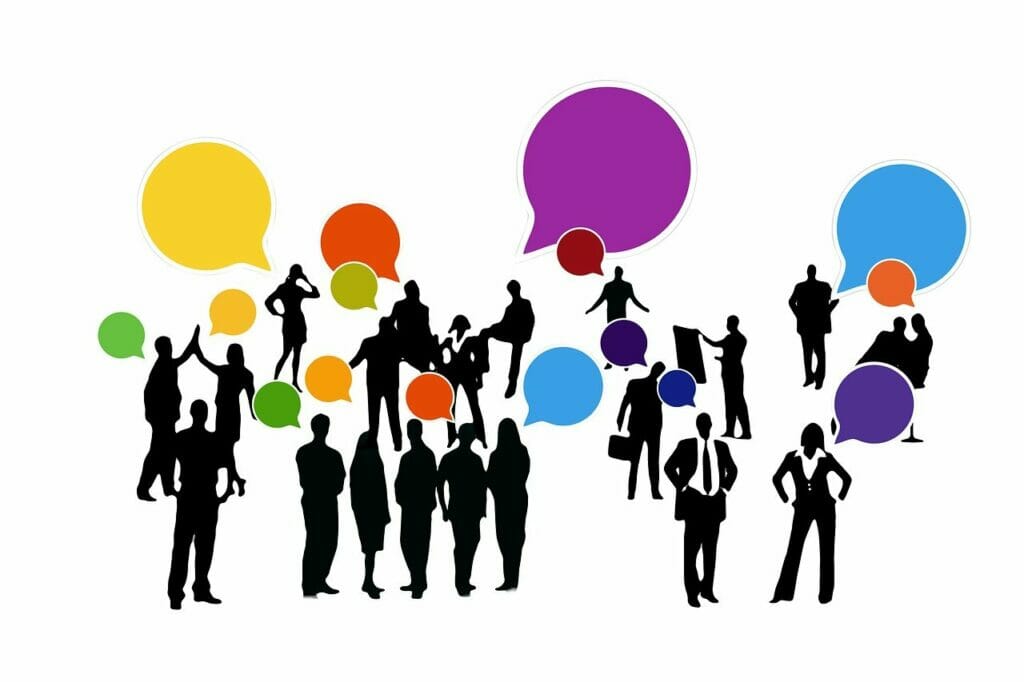
If you’re planning an international presentation, remember that your body language must be understandable to everyone . Learn about potential cultural differences between the body language you’re familiar with and what your audience understands.
Score points with the right body language in your PPT presentation!
Body language is a presentation tool which shouldn’t be ignored . Most of the time, body language happens naturally. Nevertheless, it’s important to focus on the right body language , especially during important presentations. Without a bit of forethought and practice, you can quickly come across as boring, awkward, unmotivated or unprofessional.
Use our tips and think about how you can incorporate them into your presentation. Don’t hesitate to practice in front of a familiar audience and ask for feedback. With practice, you’ll be able to perfect your body language and get the best results from your presentation . A good video summary on body language in presentations can be found here .
Extra tip: Here are some tips for online PPT presentations or when you have to present wearing a mask .
We’re happy to help you with and questions about body language, general questions about presenting or PowerPoint presentations themselves. Feel free to contact us at [email protected] .
Share this post
- share
- save

Design Thinking: Problem Solving with a Difference

Why Corporate Mission Statements Are So Important

7 Tips & Learnings from the Apple Keynote

How it works
Transform your enterprise with the scalable mindsets, skills, & behavior change that drive performance.
Explore how BetterUp connects to your core business systems.
We pair AI with the latest in human-centered coaching to drive powerful, lasting learning and behavior change.
Build leaders that accelerate team performance and engagement.
Unlock performance potential at scale with AI-powered curated growth journeys.
Build resilience, well-being and agility to drive performance across your entire enterprise.
Transform your business, starting with your sales leaders.
Unlock business impact from the top with executive coaching.
Foster a culture of inclusion and belonging.
Accelerate the performance and potential of your agencies and employees.
See how innovative organizations use BetterUp to build a thriving workforce.
Discover how BetterUp measurably impacts key business outcomes for organizations like yours.
A demo is the first step to transforming your business. Meet with us to develop a plan for attaining your goals.

- What is coaching?
Learn how 1:1 coaching works, who its for, and if it's right for you.
Accelerate your personal and professional growth with the expert guidance of a BetterUp Coach.
Types of Coaching
Navigate career transitions, accelerate your professional growth, and achieve your career goals with expert coaching.
Enhance your communication skills for better personal and professional relationships, with tailored coaching that focuses on your needs.
Find balance, resilience, and well-being in all areas of your life with holistic coaching designed to empower you.
Discover your perfect match : Take our 5-minute assessment and let us pair you with one of our top Coaches tailored just for you.

Research, expert insights, and resources to develop courageous leaders within your organization.
Best practices, research, and tools to fuel individual and business growth.
View on-demand BetterUp events and learn about upcoming live discussions.
The latest insights and ideas for building a high-performing workplace.
- BetterUp Briefing
The online magazine that helps you understand tomorrow's workforce trends, today.
Innovative research featured in peer-reviewed journals, press, and more.
Founded in 2022 to deepen the understanding of the intersection of well-being, purpose, and performance
We're on a mission to help everyone live with clarity, purpose, and passion.
Join us and create impactful change.
Read the buzz about BetterUp.
Meet the leadership that's passionate about empowering your workforce.

For Business
For Individuals
6 presentation skills and how to improve them

Jump to section
What are presentation skills?
The importance of presentation skills, 6 presentation skills examples, how to improve presentation skills.
Tips for dealing with presentation anxiety
Learn how to captivate an audience with ease
Capturing an audience’s attention takes practice.
Over time, great presenters learn how to organize their speeches and captivate an audience from start to finish. They spark curiosity, know how to read a room , and understand what their audience needs to walk away feeling like they learned something valuable.
Regardless of your profession, you most likely use presentation skills on a monthly or even weekly basis. Maybe you lead brainstorming sessions or host client calls.
Developing effective presentation skills makes it easier to contribute ideas with confidence and show others you’re someone to trust. Although speaking in front of a crowd sometimes brings nerves and anxiety , it also sparks new opportunities.
Presentation skills are the qualities and abilities you need to communicate ideas effectively and deliver a compelling speech. They influence how you structure a presentation and how an audience receives it. Understanding body language , creating impactful visual aids, and projecting your voice all fall under this umbrella.
A great presentation depends on more than what you say. It’s about how you say it. Storytelling , stage presence, and voice projection all shape how well you express your ideas and connect with the audience. These skills do take practice, but they’re worth developing — especially if public speaking makes you nervous.
Engaging a crowd isn’t easy. You may feel anxious to step in front of an audience and have all eyes and ears on you.
But feeling that anxiety doesn’t mean your ideas aren’t worth sharing. Whether you’re giving an inspiring speech or delivering a monthly recap at work, your audience is there to listen to you. Harness that nervous energy and turn it into progress.
Strong presentation skills make it easier to convey your thoughts to audiences of all sizes. They can help you tell a compelling story, convince people of a pitch , or teach a group something entirely new to them. And when it comes to the workplace, the strength of your presentation skills could play a part in getting a promotion or contributing to a new initiative.
To fully understand the impact these skills have on creating a successful presentation, it’s helpful to look at each one individually. Here are six valuable skills you can develop:
1. Active listening
Active listening is an excellent communication skill for any professional to hone. When you have strong active listening skills, you can listen to others effectively and observe their nonverbal cues . This helps you assess whether or not your audience members are engaged in and understand what you’re sharing.
Great public speakers use active listening to assess the audience’s reactions and adjust their speech if they find it lacks impact. Signs like slouching, negative facial expressions, and roaming eye contact are all signs to watch out for when giving a presentation.
2. Body language
If you’re researching presentation skills, chances are you’ve already watched a few notable speeches like TED Talks or industry seminars. And one thing you probably noticed is that speakers can capture attention with their body language.
A mixture of eye contact, hand gestures , and purposeful pacing makes a presentation more interesting and engaging. If you stand in one spot and don’t move your body, the audience might zone out.

3. Stage presence
A great stage presence looks different for everyone. A comedian might aim for more movement and excitement, and a conference speaker might focus their energy on the content of their speech. Although neither is better than the other, both understand their strengths and their audience’s needs.
Developing a stage presence involves finding your own unique communication style . Lean into your strengths, whether that’s adding an injection of humor or asking questions to make it interactive . To give a great presentation, you might even incorporate relevant props or presentation slides.
4. Storytelling
According to Forbes, audiences typically pay attention for about 10 minutes before tuning out . But you can lengthen their attention span by offering a presentation that interests them for longer. Include a narrative they’ll want to listen to, and tell a story as you go along.
Shaping your content to follow a clear narrative can spark your audience’s curiosity and entice them to pay careful attention. You can use anecdotes from your personal or professional life that take your audience along through relevant moments. If you’re pitching a product, you can start with a problem and lead your audience through the stages of how your product provides a solution.
5. Voice projection
Although this skill may be obvious, you need your audience to hear what you’re saying. This can be challenging if you’re naturally soft-spoken and struggle to project your voice.
Remember to straighten your posture and take deep breaths before speaking, which will help you speak louder and fill the room. If you’re talking into a microphone or participating in a virtual meeting, you can use your regular conversational voice, but you still want to sound confident and self-assured with a strong tone.
If you’re unsure whether everyone can hear you, you can always ask the audience at the beginning of your speech and wait for confirmation. That way, they won’t have to potentially interrupt you later.
Ensuring everyone can hear you also includes your speed and annunciation. It’s easy to speak quickly when nervous, but try to slow down and pronounce every word. Mumbling can make your presentation difficult to understand and pay attention to.

6. Verbal communication
Although verbal communication involves your projection and tone, it also covers the language and pacing you use to get your point across. This includes where you choose to place pauses in your speech or the tone you use to emphasize important ideas.
If you’re giving a presentation on collaboration in the workplace , you might start your speech by saying, “There’s something every workplace needs to succeed: teamwork.” By placing emphasis on the word “ teamwork ,” you give your audience a hint on what ideas will follow.
To further connect with your audience through diction, pay careful attention to who you’re speaking to. The way you talk to your colleagues might be different from how you speak to a group of superiors, even if you’re discussing the same subject. You might use more humor and a conversational tone for the former and more serious, formal diction for the latter.
Everyone has strengths and weaknesses when it comes to presenting. Maybe you’re confident in your use of body language, but your voice projection needs work. Maybe you’re a great storyteller in small group settings, but need to work on your stage presence in front of larger crowds.
The first step to improving presentation skills is pinpointing your gaps and determining which qualities to build upon first. Here are four tips for enhancing your presentation skills:
1. Build self-confidence
Confident people know how to speak with authority and share their ideas. Although feeling good about your presentation skills is easier said than done, building confidence is key to helping your audience believe in what you’re saying. Try practicing positive self-talk and continuously researching your topic's ins and outs.
If you don’t feel confident on the inside, fake it until you make it. Stand up straight, project your voice, and try your best to appear engaged and excited. Chances are, the audience doesn’t know you’re unsure of your skills — and they don’t need to.
Another tip is to lean into your slideshow, if you’re using one. Create something colorful and interesting so the audience’s eyes fall there instead of on you. And when you feel proud of your slideshow, you’ll be more eager to share it with others, bringing more energy to your presentation.
2. Watch other presentations
Developing the soft skills necessary for a good presentation can be challenging without seeing them in action. Watch as many as possible to become more familiar with public speaking skills and what makes a great presentation. You could attend events with keynote speakers or view past speeches on similar topics online.
Take a close look at how those presenters use verbal communication and body language to engage their audiences. Grab a notebook and jot down what you enjoyed and your main takeaways. Try to recall the techniques they used to emphasize their main points, whether they used pauses effectively, had interesting visual aids, or told a fascinating story.

3. Get in front of a crowd
You don’t need a large auditorium to practice public speaking. There are dozens of other ways to feel confident and develop good presentation skills.
If you’re a natural comedian, consider joining a small stand-up comedy club. If you’re an avid writer, participate in a public poetry reading. Even music and acting can help you feel more comfortable in front of a crowd.
If you’d rather keep it professional, you can still work on your presentation skills in the office. Challenge yourself to participate at least once in every team meeting, or plan and present a project to become more comfortable vocalizing your ideas. You could also speak to your manager about opportunities that flex your public speaking abilities.
4. Overcome fear
Many people experience feelings of fear before presenting in front of an audience, whether those feelings appear as a few butterflies or more severe anxiety. Try grounding yourself to shift your focus to the present moment. If you’re stuck dwelling on previous experiences that didn’t go well, use those mistakes as learning experiences and focus on what you can improve to do better in the future.
Tips for dealing with presentation anxiety
It’s normal to feel nervous when sharing your ideas. In fact, according to a report from the Journal of Graduate Medical Education, public speaking anxiety is prevalent in 15–30% of the general population .
Even though having a fear of public speaking is common, it doesn’t make it easier. You might feel overwhelmed, become stiff, and forget what you were going to say. But although the moment might scare you, there are ways to overcome the fear and put mind over matter.
Use these tactics to reduce your stress when you have to make a presentation:
1. Practice breathing techniques
If you experience anxiety often, you’re probably familiar with breathing techniques for stress relief . Incorporating these exercises into your daily routine can help you stop worrying and regulate anxious feelings.
Before a big presentation, take a moment alone to practice breathing techniques, ground yourself, and reduce tension. It’s also a good idea to take breaths throughout the presentation to speak slower and calm yourself down .
2. Get organized
The more organized you are, the more prepared you’ll feel. Carefully outline all of the critical information you want to use in your presentation, including your main talking points and visual aids, so you don’t forget anything. Use bullet points and visuals on each slide to remind you of what you want to talk about, and create handheld notes to help you stay on track.
3. Embrace moments of silence
It’s okay to lose your train of thought. It happens to even the most experienced public speakers once in a while. If your mind goes blank, don’t panic. Take a moment to breathe, gather your thoughts, and refer to your notes to see where you left off. You can drink some water or make a quick joke to ease the silence or regain your footing. And it’s okay to say, “Give me a moment while I find my notes.” Chances are, people understand the position you’re in.

4. Practice makes progress
Before presenting, rehearse in front of friends and family members you trust. This gives you the chance to work out any weak spots in your speech and become comfortable communicating out loud. If you want to go the extra mile, ask your makeshift audience to ask a surprise question. This tests your on-the-spot thinking and will prove that you can keep cool when things come up.
Whether you’re new to public speaking or are a seasoned presenter, you’re bound to make a few slip-ups. It happens to everyone. The most important thing is that you try your best, brush things off, and work on improving your skills to do better in your next presentation.
Although your job may require a different level of public speaking than your favorite TED Talk , developing presentation skills is handy in any profession. You can use presentation skills in a wide range of tasks in the workplace, whether you’re sharing your ideas with colleagues, expressing concerns to higher-ups, or pitching strategies to potential clients.
Remember to use active listening to read the room and engage your audience with an interesting narrative. Don’t forget to step outside your comfort zone once in a while and put your skills to practice in front of a crowd. After facing your fears, you’ll feel confident enough to put presentation skills on your resume.
If you’re trying to build your skills and become a better employee overall, try a communications coach with BetterUp.
Elevate your communication skills
Unlock the power of clear and persuasive communication. Our coaches can guide you to build strong relationships and succeed in both personal and professional life.
Elizabeth Perry, ACC
Elizabeth Perry is a Coach Community Manager at BetterUp. She uses strategic engagement strategies to cultivate a learning community across a global network of Coaches through in-person and virtual experiences, technology-enabled platforms, and strategic coaching industry partnerships. With over 3 years of coaching experience and a certification in transformative leadership and life coaching from Sofia University, Elizabeth leverages transpersonal psychology expertise to help coaches and clients gain awareness of their behavioral and thought patterns, discover their purpose and passions, and elevate their potential. She is a lifelong student of psychology, personal growth, and human potential as well as an ICF-certified ACC transpersonal life and leadership Coach.
The 11 tips that will improve your public speaking skills
The importance of good speech: 5 tips to be more articulate, learn types of gestures and their meanings to improve your communication, why it's good to have a bff at work and how to find one, why we need to reframe potential into readiness, love them or hate them, meetings promote social learning and growth, what’s my earning potential determining the right salary, show gratitude with “thank you for your leadership and vision” message examples, discover how to get noticed by upper management at work, similar articles, how to write a speech that your audience remembers, 8 tip to improve your public speaking skills, impression management: developing your self-presentation skills, 30 presentation feedback examples, your guide to what storytelling is and how to be a good storyteller, how to give a good presentation that captivates any audience, 8 clever hooks for presentations (with tips), how to make a presentation interactive and exciting, stay connected with betterup, get our newsletter, event invites, plus product insights and research..
3100 E 5th Street, Suite 350 Austin, TX 78702
- Platform Overview
- Integrations
- Powered by AI
- BetterUp Lead
- BetterUp Manage™
- BetterUp Care™
- Sales Performance
- Diversity & Inclusion
- Case Studies
- Why BetterUp?
- About Coaching
- Find your Coach
- Career Coaching
- Communication Coaching
- Life Coaching
- News and Press
- Leadership Team
- Become a BetterUp Coach
- BetterUp Labs
- Center for Purpose & Performance
- Leadership Training
- Business Coaching
- Contact Support
- Contact Sales
- Privacy Policy
- Acceptable Use Policy
- Trust & Security
- Cookie Preferences
5 body language tips to improve your presentations
"What does body language have to do with a PowerPoint presentation?" you ask. Well, more than you think. In the same way it's always worth putting some thought into the placement of our text and images or the way we design a slide, it's also worth thinking about the placement of other things "outside of the presentation" like our hands and eyes, as well as the way we present ourselves (no pun intended).
The thing is, you're using body language whether you realise it or not. There's no vacuum here, so you may as well be intentional about it. Being aware of and leveraging the way you come across when presenting can be a great way to add that extra layer of clarity, conviction or persuasion we need to win that pitch, secure that raise or get the team on board for the next project.
Your body language can either help you engage your audience and be confident and relaxed during your presentation, or make you look dull and uninterested thanks to slouching, lack of eye contact or nervous pacing back and forth. So, while we normally focus on helping you design your slides, in this post, we're giving you five pointers to help you look as good as your deck!

If you're nervous, your body will often instinctively try to avoid eye contact. If you're overly confident, you might stare for too long, making the other person nervous. The goal here is to find that sweet spot and look for long enough to appear confident without coming across as creepy.
Here are a few tips for healthy eye contact:
- Aim to move around and look at everyone in the room at least once
- Try about 2 seconds – less looks nervous, longer feels awkward
- If you're too nervous to lock in, try looking just above people's eyes
- Don't look down at your notes the whole time if you're aiming to connect
2. Use hand gestures ... the right ones, that is

According to a study by Vanessa Van Edwards , lead investigator for Science of People, hand gestures are among the five essential ingredients that make up a successful TED talk. I ntentional, well-timed hand gestures can show your audience that you care about the topic and that you're a knowledgable and effective communicator. On the flipside, unintentional hand gestures can easily cause distraction and make you look nervous or unprofessional and even annoying.
Here are a few common ones to avoid:
- Fiddling with a watch, wedding band or microphone
- Playing with keys, pens, coins or stuff in your pocket
- Stroking your hair, beard, mustache (or eyebrows!)
- Repeatedly adjusting items of clothing
- Pointing at people
And a few to try:
- Pausing to point an important element or message on your slide
- Using welcoming, positive gestures to engage with the audience
- Using a gesture to invite the audience to answer a question
- Counting key points on your fingers for emphasis
- Clapping to celebrate or acknowledge an achievement
3. Consider your clothes

A lot can be said about people's choice of clothing, and there are obviously plenty of landmines to be mindful of here, including everything from company dress code to individual taste. We won't go too deep here, and also try to leave some room for personal preferences, but here are a few questions to ask yourself:
Are your clothes enhancing your message or distracting people?
A t-shirt with an eye-catching design or some provocative wording might be perfect for a night on the town, but if it's not supporting your message, it may be distracting and detracting from it. If in doubt, go neutral. Plainer clothes are often a good choice, or at least items of clothing that don't carry conflicting messaging.
How will your audience be dressed?
If they're in suits, you might not want to rock up in swimwear, unless of course you're doing a talk on water safety, in which case it might be an appropriate way to grab, and hold, people's attention. Many suggest dressing slightly better than your audience, helping establish some level of professionalism while also hanging on to some relatability.
Are your clothes clean, ironed and in decent condition?
We're not suggesting you invest in a new wardrobe every time you need to get the team together for a 5-minute stand-up meeting at the office, but it's worth checking your clothes are neat and tidy enough not to distract people while you're talking. There's nothing worse than staring at a guy with big square-shaped creases on his recently purchased shirt because he didn't allow time to iron it before taking the stage.
4. Remember your posture

Body language matters. As mentioned in one of the earlier tips, a poor posture such as slouching will give your audience the impression that you’re not confident nor interested in your topic or yourself. If you're tense, they'll sense your nervousness. Remind yourself to relax throughout your presentation and to straighten up if you start to slouch. Not only will this give you the chance to improve your posture, but it'll also allow your audience to take in the points you’ve just covered.
Within your own personal style, try to be comfortably confident.
So here are two dos and two don'ts when it comes to posture during a presentation:
- Don't slouch – Your posture should be upright and open. This'll make you look and feel more confident, inviting the audience in rather than pushing them away.
- Try not to be tense – It’s important to look and feel relaxed during a presentation. Appearing too rigid won’t make a good impression. No matter how nervous you may feel, a speaker who seems to be afraid of his or her audience will not win their trust. Remind yourself to relax at different points throughout the presentation. Use your pauses to consciously to relax and reset your expression and posture.
- Think about your audience – A formal presentation to the board of a company is quite different from an interactive talk with a junior coworker. While you still need to be upright, open, and relaxed in all situations, remember that different settings require different levels of formality. Adapt your posture and the delivery of your message to be more open or more formal accordingly.
Read more: 10 dos and don'ts of impactful presentations
5. Don't forget to breathe

Whether you're nervous, excited or insecure about delivering a presentation to an audience, it's surprisingly common to either freeze or to speak faster than normal, leading you to experience a shortness of breath. Regardless of how you feel about presenting, it's important to remember to breathe normally. It's a great way to center yourself, find some calm and take control of the situation. Breathing at a healthy pace will also give you the chance to gather your thoughts in between points, and most importantly, give your audience the opportunity to take in what you've just said.
Much like eye contact, pausing to breathe needs to be timed well. Too short and you seem flustered, too long and it gets awkward. Try delivering a sentence or two and then pausing to breathe. Soon, you'll find a rhythm and cadence that enables both you and your audience to settle in for the ride so they remain focused and curious, and you stay calm and in complete control.

Recent Articles
How to source new assets from pickit stock™.
We all know there's a steady supply of images on the internet, but unfortunately, they're not...
How DAM can boost your business
It goes without saying that in recent years, the digital workspace has undergone some serious...
A few insights from 5 years of remote work with Pickit
If you’ve spent any time on LinkedIn lately, you’ve probably already been bombarded with advice...

How to use body language during a presentation
- 19 February 2018
- 10 minute read

It’s easy to spend a long time agonising over what to say when it comes to giving a presentation. However, it’s important to remember that a great presentation is about much more than just content. Elsewhere on the Future Skills Blog we’ve talked about the most important public speaking skills to have in general, but here we’re going to focus on body language.
Body language can make all the difference between a dull, static presentation and a dynamic, engaging one. Of course, body language has many different elements, and so we’ve broken it down into five categories:
- Facial expressions
- Eye contact
- Position and movement
Some of these may seem like small details, but they have a big impact on how your presentation comes across. When your body language is working hand in hand with the other aspects of your presentation, such as content and tone of voice, then you’re sure to win over your audience.
1) Facial expressions
People will travel half-way around the world to meet one another “face-to-face” for a reason – when it comes to interacting with others, what we do with our faces is vital. We may not usually control our facial expressions in any conscious way, but there are times when we have to think about what our face is telling others, such as when giving a presentation. Study-body-language.com has produced a fun guide to facial expressions and why they matter.
The first and most obvious thing to remember is to make sure that you are using your face at all. Giving a presentation with a blank face, without any particular facial expression is like speaking in a monotone – no matter how great your content is, your audience will not be engaged. Even some simple steps from the outset, such as opening your eyes wider, raising your eyebrows a little, and smiling, can make a huge difference in setting the tone for your presentation. You can also “reset” at different points during your presentation to make sure that you haven’t fallen back into a dull resting expression and to re-engage your audience’s attention.
Of course, putting rehearsed facial expressions into your speech mechanically is never going to be effective, and what you do with your face should look natural. The important thing is to be attentive to what you’re saying. If your facial expressions are in line with the tone of your words, then the information you are presenting will come across more clearly, and you will seem more sincere. Remember that the expression you wear tells people a lot about how trustworthy you are. Don’t forget that the size of the room and the audience matters too – a bigger crowd requires bigger facial expressions.
2) Eye contact
Having thought about what your face is doing in general, it’s time to get even more specific and think about eye contact. This is crucial when it comes to communication, as explored in a recent Psychology Today article .
Just as with facial expressions and the other parts of body language we’ll be looking at below, the way in which you use eye contact and look at your audience depends on the size of the room and the audience. However, here are some general tips:
- Make sure you look at everyone – Staring at the same spot throughout a presentation is visually dull and unengaging for your audience. Make sure that by the end of your presentation you have made eye contact with everyone at least once – that might mean every individual if you have a small audience, or every section of a crowd if you have a bigger audience.
- Don’t be afraid of eye contact – Prolonged eye contact can make people nervous, but that’s because it’s so powerful. You may be perceived as aggressive or bullying. A brief glance, however, suggests that you are monitoring their expression as you speak to them, and thus that you care about how your message is being received. While it may be tempting to find a spot to stare at on the back wall, it is always better to try and make a more personal connection with members of your audience. But remember…
- Don’t stare – No one wants to feel uncomfortable or that they are being put on the spot. Keep your gaze moving and engage as many people as possible.
Again, remember that different situations call for different approaches, but as long as you are consciously using eye contact, you’ll be well on the way to making your presentation as involving as possible.
We’ve talked about facial expressions and eye contact, now it’s time to look at the bigger picture: posture. Whether you’re sitting or standing, the way in which you hold yourself is incredibly important and sets the tone for the whole presentation before it’s even begun.
With this in mind, here are a few Do’s and Don’ts when it comes to posture during a presentation:
- DON’T slouch – In almost all presentation situations, your posture should be upright and open. This will make you look and feel more confident, and it will invite your audience in rather than pushing them away. If you are not sitting or standing upright it suggests that what you have to say is not particularly important to you. If you suggest to your audience that what you have to say is not really worthy of your attention they are unlikely to pay much attention either.
- DON’T be tense – It’s important to look and feel relaxed during a presentation. If you’re standing upright but look rigid, it won’t make a good impression. No matter how nervous you may feel, a speaker who seems to be afraid of his audience will not win their trust. Pause and take a deep breath before you begin, and remind yourself to relax at different points throughout the presentation. Pausing and giving your audience time to think about what you have just said is a good thing to do anyway. You can take that time consciously to relax and re-set your expression and posture.
- DO think about your audience – A formal presentation to the board of a company is very different to an interactive talk with schoolchildren. While you still need to be upright, open and relaxed in all situations, remember that different situations require different levels of formality. Do you want to be interrupted if someone has a question for example, or will you only take questions at the end of your presentation? Adapt your posture to be more open or more formal accordingly.
- DO be adaptable – If you are sat down or have a lectern for your presentation, don’t hold onto them for support or let them get in the way. You should have an open and communicative posture no matter what the specific set-up is. Be prepared to adapt to unexpected situations. If you are addressing a large audience or being recorded you may need to use a microphone – this may mean you have to remain at a lectern, or you have to hold a microphone in one hand, which can restrict your gestures. Try to find out beforehand, but if things are not at you expected, adapt quickly to make the best of the facilities provided.
In addition, Ethos3 also gives some very helpful advice on how to improve your posture for a presentation .
4) Gestures
Varied facial expressions, eye contact and a good posture will put you well on the way to presentation success, but if you stand still without moving any other part of your body, it can create a very strange impression. On the other hand, over-rehearsed or exaggerated hand gestures can be off-putting and look unnatural.
A happy medium is needed. Remember that the purpose of using gestures when giving a presentation is to make your message clearer and more interesting. In short, your gestures should mean something. For example, if you are making a contrast between big and small, you can use hand gestures to represent this. If you are giving a numbered list, you can show the numbers with your hand so that both people’s eyes and ears are engaged. Alternatively, if you want to address the audience directly, you can gesture towards them (but try not to point aggressively as though you’re accusing them of something). If you have a PowerPoint slideshow or other visual aids, use gestures to draw people’s attention to them. If you have a particular point which is one of the key messages of your presentation you may want to make your gestures more exaggerated as you work up to that point – in this way you can communicate to the audience which of the things you have to say matter most to you.
The Science of People blog’s article on hand gestures gives some great insight into this aspect of presentation along with some further ideas. Remember that whatever happens, gestures should look relaxed and natural. If you are struggling with this, remember that practice makes perfect – film yourself presenting or ask your friends to give you feedback. Also, as with all the other aspects of body language we’ve been talking about, you’ll need to adjust things depending on the size of the room.
5) Position and movement
This last area is more variable depending on the specific set-up of your presentation. It will be clear straight away whether you have any flexibility over where you position yourself or if movement around the space is even possible, but it’s always worth considering.
For example, if you are giving your presentation on a big stage, a bit of movement around the space can help to create visual interest and keep different parts of the audience engaged. Likewise, if your presentation has interactive elements, you could move closer or slightly further back from the audience depending on whether they’re involved or not. The golden rule is that any movement should be clear and directed – you should never look like you’re just wandering around the stage. You may, for example, want to engage your audience early on in your presentation by moving to the front of the stage and asking them a question – “Who can tell me…”, “Put your hand up if you have ever…” – this not only enables you to make some judgements about how much your audience already knows about what you have to say, it also engages them and suggests that you care about their experiences. Most people are much happier if they feel a speaker is “talking to” them rather than “talking at” them with no concern for their opinions.
The five topics above give an overall sense of how you can use body language to make your presentation clearer, more engaging and more powerful. Remember that body language is not something you apply later to a pre-written script, but a core part of how you present. It should go hand-in-hand with every other aspect of the presentation, such as the content and the tone of your voice, to create a compelling overall experience for your audience. Good luck and happy presenting!

Article tagged:
- communication

14 Practical Tips to Improve Your Presentation Skills
- The Speaker Lab
- May 11, 2024
Table of Contents
Ever felt complete dread and fear at the thought of stepping up to deliver a presentation? If so, you’re not alone. The fear of public speaking is more common than you might think, but with the right presentation skills , it’s a hurdle that can be overcome.
In this article, we’ll help you master basic confidence-building techniques and conquer advanced communication strategies for engaging presentations. We’ll explore how body language and eye contact can make or break your connection with your audience; delve into preparation techniques like dealing with filler words and nervous habits; discuss tailoring content for different audiences; and much more.
Whether you’re prepping for job interviews or gearing up for big presentations, being prepared is key. With adequate practice and the proper attitude, you can crush your speech or presentation!
Mastering the Basics of Presentation Skills
Presentation skills are not just about speaking in front of a crowd. It’s also about effective communication, audience engagement, and clarity. Mastering these skills can be transformative for everyone, from students to corporate trainers.
Building Confidence in Presentations
Becoming confident when presenting is no small feat. But fear not. Even those who feel jittery at the mere thought of public speaking can become masters with practice and patience. Just remember: stage fright is common and overcoming it is part of the process towards becoming an effective presenter.
Taking deep breaths before you start helps calm nerves while visualizing success aids in building confidence. Also, know that nobody minds if you take a moment to gather your thoughts during your presentation—everybody minds more if they cannot understand what you’re saying because you’re rushing.
The Role of Practice in Enhancing Presentation Skills
In line with old wisdom, practice indeed makes perfect, especially when improving presentation skills. Consistent rehearsals allow us to fine-tune our delivery methods like maintaining eye contact or controlling body language effectively.
You’ll learn better control over filler words through repeated drills. Plus, the extra practice can help you troubleshoot any technical glitches beforehand, saving you the sudden panic during your actual presentations.
Remember that great presenters were once beginners too. Continuous effort will get you there sooner rather than later.
Find Out Exactly How Much You Could Make As a Paid Speaker
Use The Official Speaker Fee Calculator to tell you what you should charge for your first (or next) speaking gig — virtual or in-person!
Body Language and Eye Contact in Presentations
The effectiveness of your presentation can hinge on more than just the words you say. Just as important is your body language .
Impact of Posture on Presentations
Your posture speaks volumes before you utter a word. Standing tall exudes confidence while slouching could signal nervousness or lack of preparation.
If there’s one lesson to take away from our YouTube channel , it’s this: good presenters know their message but great ones feel it through every fiber (or muscle) of their being. The audience can sense that energy when they see open body language rather than crossed arms.
Maintaining Eye Contact During Your Presentation
Eyes are often called windows to the soul for a reason. They’re communication powerhouses. Making eye contact helps build trust with your audience members and keeps them engaged throughout your speech.
Avoid staring at note cards or visual aids too much as this might give an impression that you’re unprepared or uncertain about your chosen topic. Instead, aim to maintain eye contact between 50% of the time during presentations. This commonly accepted “50/70 rule” will help you exhibit adequate confidence to your audience.
If stage fright has gotten a hold on you, take deep breaths before you start speaking in order to stay calm. Make sure that fear doesn’t disrupt your ability to maintain eye-contact during presentations.
If body language and eye contact still feel like a lot to manage during your big presentation, remember our golden rule: nobody minds small mistakes. It’s how you handle questions or mishaps that truly makes a difference—so stay positive and enthusiastic.
Preparation Techniques for Successful Presentations
Presentation skills are like a craft that requires meticulous preparation and practice. Aspects like visual aids and time management contribute to the overall effectiveness of your delivery.
The first step towards delivering an impactful presentation is research and organization. The content should be well-researched, structured logically, and presented in simple language. This will make sure you deliver clear messages without any room for misinterpretation.
Dealing with Filler Words and Nervous Habits
Nervous habits such as excessive use of filler words can distract from your message. Luckily, there are plenty of strategies that can address these issues. For instance, try taking deep breaths before speaking or using note cards until fluency is achieved. In addition, practice regularly to work on eliminating these verbal stumbling blocks.
Avoiding Distractions During Presentations
In a digital age where distractions abound, maintaining focus during presentations has become an even more crucial part of the preparation process. This video by motivational speaker Brain Tracy provides insights on how one could achieve this level of focus required for effective presentations.
Maintaining Confidence Throughout Your Presentation
Confidence comes from thorough understanding of the chosen topic combined with regular practice sessions before the big day arrives. Make use of note cards or cue cards as needed but avoid reading from them verbatim.
Taking control over stage fright starts by arriving early at the venue so that you familiarize yourself with the surroundings, which generally calms nerves down considerably. So next time you feel nervous before a big presentation, remember—thorough preparation can make all the difference.
Engaging Your Audience During Presentations
Connecting with your audience during presentations is an art, and mastering it can take your presentation skills to the next level. Making the message conveyed reach an emotional level is essential, not just conveying facts.
Understanding Your Target Audience
The first step towards engaging your audience is understanding them. Tailor the content of your presentation to their needs and interests. Speak in their language—whether that be professional jargon or everyday slang—to establish rapport and ensure comprehension.
An effective presenter understands who they’re speaking to, what those individuals care about, and how best to communicate complex ideas understandably.
Making Complex Information Understandable
Dense data or complicated concepts can lose even the most interested listener if presented ineffectively. Breaking your key points down into manageable chunks helps maintain attention while promoting retention. Analogies are especially useful for this purpose as they make unfamiliar topics more relatable.
Audience Participation & Questions: A Two-Way Street
Incorporating opportunities for audience participation encourages engagement at another level. It allows listeners to become active participants rather than passive receivers of knowledge.
Consider techniques like live polls or interactive Q&A sessions where you invite questions from attendees mid-presentation instead of saving all queries until the end.
This gives you a chance not only engage but also address any misunderstandings right on spot.
- Treat each question asked as an opportunity—it’s evidence someone has been paying attention. Even challenging questions should be welcomed as they demonstrate an engaged, thoughtful audience.
- Encourage participation. It can be as simple as a show of hands or the use of interactive technologies for live polling during your presentation. This keeps your audience active and invested in the content.
Remember, your presentation isn’t just about putting on a show—it’s about meaningful interaction.
Free Download: 6 Proven Steps to Book More Paid Speaking Gigs in 2024
Download our 18-page guide and start booking more paid speaking gigs today!
Presentation Skills in Specific Contexts
Whether you’re nailing your next job interview, presenting an exciting marketing campaign, or delivering insightful educational content, the context matters. Let’s take a look.
The Art of Job Interviews
A successful job interview often hinges on effective communication and confidence. Here, the target audience is usually small but holds significant influence over your future prospects. Body language plays a crucial role; maintain eye contact to show sincerity and interest while open body language communicates approachability.
Bullet points summarizing key experiences are also helpful for quick recall under pressure. This allows you to present your chosen topic with clarity and positive enthusiasm without relying heavily on note or cue cards.
Pitching in Public Relations & Marketing
In public relations (PR) and marketing contexts, presentations need to capture attention quickly yet hold it long enough to deliver key messages effectively. Visual aids are valuable tools here—they help emphasize points while keeping the audience engaged.
Your aim should be highlighting presentation benefits that resonate with potential clients or partners, making them feel as though ignoring such opportunities would mean missing out big time.
Educational Presentations
An educational setting demands its own unique set of presentation skills where deep understanding trumps flashy visuals. You must make complex information understandable without oversimplifying essential details—the use of analogies can be beneficial here.
Keeping the audience’s attention is critical. Encourage questions and participation to foster a more interactive environment, enhancing learning outcomes for all audience members.
Tips for Becoming a Great Presenter
No single method is suitable for everyone when it comes to speaking in public. However, incorporating continuous improvement and practice into your routine can make you an exceptional presenter.
Tailor Your Presentation to Your Audience
Becoming an excellent speaker isn’t just about delivering information; it’s also about making a connection with the audience. So make sure that you’re taking setting, audience, and topic into consideration when crafting your presentation. What works for one audience may not work for another, so be sure to adapt your presentation styles according to the occasion in order to be truly effective.
The Power of Practice
The art of mastering public speaking skills requires practice —and lots of it . To become a great presenter, focus on improving communication skills through practice and feedback from peers or mentors. Try to seek feedback on every speech delivered and incorporate those pointers in your future presentations. Over time, this cycle of delivery-feedback-improvement significantly enhances your ability to connect with audiences and convey ideas effectively.
If you’re looking for examples of good speakers, our speech breakdowns on YouTube provide excellent examples of experienced presenters who masterfully utilize speaking techniques. Analyzing their strategies could give you great ideas for enhancing your own style.
Finding Your Style
A crucial part of captivating any audience lies in how you deliver the message rather than the message itself. Developing a unique presentation style lets you stand out as an engaging speaker who commands attention throughout their talk. Through — you guessed it — practice, you can develop a personal presentation style that resonates with listeners while showcasing your expertise on the chosen topic.
Your body language plays a pivotal role here: open gestures communicate confidence and enthusiasm towards your subject matter, two qualities essential for keeping audiences hooked. Similarly, using vocal variety adds dynamism to speeches by emphasizing points when needed or creating suspense during storytelling parts of your talk.
Cultivating Passion & Enthusiasm
Showcasing genuine passion for the subject helps keep listeners engaged throughout even lengthy presentations. Sharing stories related to the topic or expressing excitement about sharing knowledge tends to draw people in more than mere data recitation ever could.
Recognize that everybody is distinctive; don’t expect identical results from every speaker. The path to becoming a great presenter involves recognizing your strengths and working tirelessly on areas that need improvement.
FAQs on Presentation Skills
What are good presentation skills.
Good presentation skills include a clear message, confident delivery, engaging body language, audience understanding, and interaction. They also involve effective preparation and practice.
What are the 5 steps of presentation skills?
The five steps of presenting include: planning your content, preparing visual aids if needed, practicing the delivery aloud, performing it with confidence, and finally post-presentation reflection for improvements.
What are the 5 P’s of presentation skills?
The five P’s stand for Preparation (researching your topic), Practice (rehearsing your talk), Performance (delivering with confidence), Posture (standing tall), and Projection (using a strong voice).
What are your presentation skills?
Your personal set of abilities to deliver information effectively is what we call your presentation skill. It can encompass public speaking ability, clarity in speech or writing as well as visual communication talent.
Mastering presentation skills isn’t an overnight process, but practice and perseverance will put you well on your way to becoming an effective speaker.
You’ve learned that confidence plays a crucial role in effective presentations, so take deep breaths, make eye contact, and keep your body language open. As always, preparation is key. Tackle filler words head-on and get comfortable with visual aids for impactful storytelling.
Remember the importance of audience engagement — it’s all about understanding their needs and tailoring your content accordingly. This way, complex information turns into digestible insights.
Above all else: practice! After all, nothing beats experience when it comes to improving public speaking abilities.
- Last Updated: May 9, 2024

Explore Related Resources
Learn How You Could Get Your First (Or Next) Paid Speaking Gig In 90 Days or Less
We receive thousands of applications every day, but we only work with the top 5% of speakers .
Book a call with our team to get started — you’ll learn why the vast majority of our students get a paid speaking gig within 90 days of finishing our program .
If you’re ready to control your schedule, grow your income, and make an impact in the world – it’s time to take the first step. Book a FREE consulting call and let’s get you Booked and Paid to Speak ® .
About The Speaker Lab
We teach speakers how to consistently get booked and paid to speak. Since 2015, we’ve helped thousands of speakers find clarity, confidence, and a clear path to make an impact.
Get Started
Let's connect.
Copyright ©2023 The Speaker Lab. All rights reserved.
- Self Confidence
- Public Speaking
- Communication
- Communication Skills
LEARNER STORIES
- Kanhaiya Sharma
- Ashfaq Sorathia
- Prateek Chawla
OTHER TOOLS
- Comparative Analysis
On This Page
Communication is not just about words; it goes beyond verbal expressions. One significant aspect that plays a crucial role in our daily interactions is our body language. Often termed as nonverbal communication , body language can convey messages, emotions, and intentions without uttering a single word.
You can make people feel happy or sad, frustrated or relaxed just through your body language, which makes it very important for us to keep these expressions in check.
In this blog, we will explore the meaning of body language, its importance in communication skills, various types of body language, and some improvement tips. Let’s first understand what is body language.
Meaning Of Body Language
Your body language is the unspoken part of a conversation that we all instinctively understand and employ daily. The subtle nuances of a smile, the confident stance of a speaker, and the reassuring nod of agreement are the foundational pillars of nonverbal communication.
Your body language and the other forms of non-verbal communication cues can help you shape the dynamics of your relationships, both personal and professional.
Body language is a secret code our bodies use to communicate without words. Imagine a game of Dumb Charades or Act It Out where you use your body language; you will realise how much can be done with just a few gestures and expressions.
Your body language and quick expressions show your true feelings, even when you’re not saying anything. Your verbal communication, together with these non-verbal expressions, makes a conversation complete. But is body language that important? Is it possible to have a conversation without using your body language?
Continue reading because, in the next section, we’ll learn the science behind body language that makes it so important.
Importance Of Body Language
According to the study conducted on the importance of body language by Albert Mehrabian and Morton Wiener, 55% of communication is body language, 38% is the tone of voice, and 7% is the actual words spoken – often called the 55/38/7 formula .
This formula was developed to stress the application of body language to communication and to explain to the audience when there is an inconsistency between verbal and non-verbal communication; it is the non-verbal communication or the body language that does most of the speaking. There are five main role of body language played in communication.
Let’s dive in!

1. Repetition
Body language repeats what we speak verbally and helps us put emphasis on the spoken words. In situations where you don’t want to repeat yourself, your body language does that for you.
For instance, when you don’t want a child to do something, you say no for the first time, and then a simple nodding of your head or wagging your finger from left to right repeats the message.
2. Contradiction
We often say, ‘Our eyes speak the truth’. When your words do not align with your body language, it is a contradiction.
For example, when you do not want to tell the truth to someone, and you try to lie to them, your body language can contradict you, like avoiding eye contact or clenching your fist.
3. Substitution
Sometimes we are unable to speak what we want to due to sadness or nervousness. In such situations, your body language can substitute your verbal words.
For instance, when you are very tired but don’t say anything, your facial expression and body posture can paint a vivid picture even if you have not said a word.
4. Complementing
Body language can complement your verbal communication by making it easier for the audience to understand the message.
For instance, let’s say you are explaining to your audience the benefits of your product, and you say, “There are 3 benefits”. If you count them with your fingers while speaking the words, you draw the immediate attention of body language for the audience.
5. Accenting
Accenting means making your communication more assertive and impactful. Like when you underline a statement to put emphasis on it and body language puts emphasis on verbal communication by accenting it.
For instance, when your boss appreciates you with words, a pat on your back accents the spoken words.
Types of Body Language
We observe five recognised types of body language in communication in our daily lives.
In this section, we will learn about these five body languages, what expressions can be considered positive and negative and certain tips you can incorporate to improve these non-verbal communication skills.

1. Facial Expressions
The face of a person is like a dynamic canvas that paints a vivid picture of our emotions. Just as words convey meaning, our facial expressions reveal a wealth of information about our feelings.
Understanding how to use body language is like having a key to decipher their mood, sincerity, and reactions.
Smiles: A sincere smile, as a body language, lights up the face, crinkling the eyes and lifting the corners of the mouth. You can smile when greeting clients or colleagues, when rewarded, or when you receive a compliment; you can smile to be just polite and acknowledge when a person shares an idea. While smiling, it has to be kept in mind that smiling too much can seem insincere, while not smiling may be considered cold by the other person. It’s essential to strike a balance by considering individual preferences and using a genuine smile.
Eye Brightening: When we’re excited, our pupils often widen, and the sparkle intensifies. It’s like our eyes are shining with energy. Similarly, a side gaze signifies the body language of curiosity and gives the other person the impression that you’re interested in a topic or any new project. Looking down at the floor or your feet signifies sadness and can signal emotional distress.
Raised Eyebrows: A subtle lift of the eyebrows signals interest or surprise. For example, saying, “I’m intrigued by what you’re saying,” or “That caught me off guard!” Though these are the positive attributes of a raised eyebrow, it can also indicate scepticism or shock. For a better understanding, a person has to read the entire context in which the body language is used.
Relaxed Forehead: A smooth forehead without furrows or wrinkles indicates a sense of ease and contentment. This body language is a symbol of a moment of peace and is used to communicate a positive emotion.

Negative Facial Expressions
Frowns: A downturned mouth and furrowed eyebrows indicate displeasure, discomfort, or disagreement. It’s like a visual cue that something isn’t quite right.
Eye Rolls: Rolling the eyes conveys impatience, irritation, or a dismissive attitude. It’s like saying, “I’ve heard enough”.
Tightened Jaw: Clenching the jaw or grinding teeth suggests stress or tension. It’s like a physical manifestation of inner pain.
Narrowed Eyes: Narrowing the eyes, often called ‘ beady eyes ’, can signal distrust or scepticism. For example, saying, “I’m not sure I believe you.”

This body language is extremely significant if you think in the context of a business meeting or an important negotiation. So, what can you do to improve your facial expressions?
Actionable Steps To Improve
Begin by becoming more aware of your facial expressions. Pay attention to how your face naturally reacts to different emotions and situations.
Use a mirror to practise different facial expressions. Experiment with conveying happiness, surprise, sadness, and other emotions.
Simple exercises like raising and lowering eyebrows or forming exaggerated smiles can help enhance expressiveness.
2. Body Posture
How we carry ourselves and our body posture is a silent but powerful tool to communicate our thoughts and feelings.
It’s like a visual script that narrates our level of confidence, interest, or disinterest without uttering a single word. Understanding the messages conveyed by posture is akin to unlocking the secrets behind the demeanour of a person.
Positive Body Postures
Upright Stance: Standing tall with an upright posture or sitting up straight with an open posture conveys confidence and assertiveness. It sends a message that a serious and significant message is being delivered. For instance, standing power poses – stand up straight, tilt your chin upward, and put your hands on your sides or even sitting power poses like the ‘Victory pose’ – raising your hands or fists above your head in a “V” shape.
Open Arms: Arms held by the sides or open in a welcoming gesture signify the body language of approachability. It’s like creating an invisible invitation for communication, like inviting someone for a hug.
Relaxed Shoulders: Shoulders down and relaxed suggest a sense of ease and comfort. It signals that you are in your happy place and feel secure.
Mirroring: Mirroring, formally called Gauchais Reaction, is a non-verbal technique where a person copies the body language, vocal qualities, or attitude of another person. This happens subconsciously and helps you build a connection and rapport.

Negative Body Postures
Slouched Shoulders: Slouching or rounded shoulders can indicate a lack of confidence and reservation of thoughts. It’s like the body expressing uncertainty or self-doubt.
Crossed Arms: Crossing arms across the chest can signal defensiveness or discomfort. Since we feel uncomfortable, we create a barrier around us with our arms, saying, “I need some space.”
Turned Away: Turning the body away from someone may indicate disinterest or disengagement in the conversation. It’s like physically expressing a desire to distance oneself.
Tightly Clenched Hands: Clenching fists or tightly holding onto an object can indicate anxiety or tension. It’s like the body physically holding onto stress, unwilling to let go.

It is natural to exhibit negative body postures when upset, dissatisfied or tired. However, in professional situations, you do not get the privilege of choosing to have a slouched shoulder or depict negative body language.
Let’s see how to improve your body postures to exude a positive image.
Notice how you sit, stand, and move. Identify any habits or tendencies that contribute to poor posture.
Set up your workspace ergonomically. Adjust the height of your chair, desk, and computer monitor to promote a neutral spine position.
Engage in exercises and activities like yoga or Pilates that focus on flexibility, balance, and core strength.
3. Hand Gestures
Gestures are like the dancers in the silent dance performance, moving alongside our verbal words to enhance, emphasise, and sometimes even substitute for what we’re saying. Like a well-coordinated dance, the right gestures can add flair and meaning to our verbal expressions.
However, just as in any performance, it’s essential to strike the right balance to avoid distractions.
Positive Hand Gestures
Illustrative Movements: Using hand movements to illustrate or emphasise points can make ideas clear. Some common hand gestures formed through illustrative movements are:
a) ‘The pinch gesture’, where you pinch your thumb and forefinger together to indicate something small or precise. You can use it when you want to draw someone’s attention to minute details.
b) ‘The counting gesture’, where you use your fingers to count down the key points while you explain. It complements your spoken words and helps the audience follow the structure of your message.
c) ‘The expansive gesture’ where we open both hands and create space to show the size, scope or importance of something. You can depict the extent of growth or inclusivity using this body language.
Thumbs Up: Offering a thumbs-up can convey approval or agreement. It’s like a silent way of saying, “Great job!” or “I agree with you.” However, exercising discretion while using this body language is essential because a thumbs-up may be considered offensive in some cultures.
Open-Palm Gestures: Hand gestures with open palms can signal sincerity and openness. It’s like physically demonstrating that there’s nothing to hide. Open palms can help your audience feel more comfortable.
Steeple Gestures: The steeple gesture is created by pressing the tips of your fingers together while keeping your palms apart. This is used when discussing critical concepts or conclusions with confidence and authority.

Negative Hand Gestures
Excessive Pointing: Excessive pointing, especially if directed at someone, can be perceived as aggressive or rude. It’s like a gesture that demands attention but might appear confrontational. Also, crossing arms while pointing can be defensive and may be considered accusatory. It’s like a combination that suggests disagreement or resistance.
Watching Time Frequently: Looking at your watch from time to time during a meeting or conversation gives an impression of a lack of interest. You may feel you have another urgent or immediate commitment, but the other person will feel you do not value this conversation.
Finger Wagging: Wagging a finger can signal disapproval or a warning. It’s like a non-verbal way of scolding someone or saying “no” that implies a boundary or objection.
Overly Animated Movements: While animated gestures can engage, excessive and irregular movements might distract from the message. It will draw focus from the message to the body language, which is not the objective.

Hand gesture is a tricky body language. You need to use gestures to complement your speech while ensuring you don’t overuse them. Moreover, you need to be aware of the meaning of different gestures in different parts of the world to make sure you convey the meaning that you want to convey. One of the most notable anecdotes of this was in the 1950s when Richard Nixon visited Brazil and flashed the “Ok sign” to a waiting crowd upon arriving in Rio de Janeiro, who responded with boos!
Consider the context of your communication. A casual conversation might involve more relaxed gestures, while a formal presentation might benefit from more deliberate movements.
Connect your hand gestures with the words you’re saying. If you’re describing something big, use a gesture that conveys size.
Enrol in training programs where you can receive professional guidance on non-verbal communication.
4. Eye Contact
Eye contact is a non-verbal communication that involves looking directly into someone’s eyes during a conversation or interaction. It is a powerful and fundamental aspect of human communication, conveying various social and emotional signals.
Exactly like verbal words, eye contact speaks volumes about attentiveness, sincerity, and the nature of the interaction. The meaning of eye contact can vary based on cultural norms, individual personalities, and the context of the situation.
Positive Eye Contact
Attentiveness and Focus: Maintaining direct eye contact during a conversation signals active listening and attentiveness. It’s a way of showing that you are fully engaged in what you’re saying or listening to and that you are paying undivided attention.
Sincerity and Trustworthiness: Sustained eye contact fosters a sense of sincerity and trust. It’s like a silent agreement that what is being communicated is genuine and honest.
Connection and Empathy: Eye contact helps establish a connection between individuals. It’s like a visual acknowledgement that goes beyond words, creating a shared moment of understanding.
Confidence and Assertiveness: Confident individuals often maintain steady eye contact. It’s like a non-verbal display of self-assurance and a willingness to engage.

Negative Eye Contact
Avoidance or Discomfort: A lack of eye contact may be an indicator of discomfort, shyness, or a desire to avoid confrontation. It’s like the eyes are trying to shield the person from a potentially overwhelming situation.
Deception or Dishonesty: In some cases, avoiding eye contact can be associated with dishonesty or an attempt to conceal the truth. It’s like the eyes are avoiding scrutiny to maintain a façade.
Disinterest or Distrust: When someone avoids eye contact, it might signal disinterest or distrust. It’s like a visual cue that the person may not be fully invested in the conversation.
Social Anxiety: Individuals with social anxiety might find it challenging to maintain eye contact due to a fear of judgement or being overwhelmed. It’s like the eyes reflect an internal struggle with social interactions.

Improving eye contact is a valuable skill that can enhance your communication and interpersonal interactions. Here are some actionable steps to help you improve your eye contact:
Follow the 50/70 rule – Aim to make eye contact 50% of the time when you speak and 70% of the time when you listen.
If direct eye contact feels overwhelming, try shifting your gaze from the left eye to the right eye and then towards the forehead or towards the nose and lips. This is known as the “ triangle technique ” and can create the illusion of eye contact without causing discomfort.
Take short breaks to avoid nervousness, and instead of focusing on the eyes of the listeners, aim just above their heads or at the rear wall.
5. Vocal Tone
Vocal tone refers to the quality, pitch, and modulation of one’s voice when speaking. It encompasses the way in which words are delivered, including the pitch variations from high to low or low to high, rhythm, and overall sound of the voice.
Our tone of voice and vocal pitch adds emotion, nuance, and depth to our communication, influencing how our messages are received.
Positive Vocal Tones
Warm and Affectionate: A warm and affectionate tone conveys kindness and care. It’s like wrapping your words in a gentle embrace, making the listener feel valued and understood.
Enthusiastic and Energetic: An enthusiastic and energetic tone injects vitality into the message. It’s like a burst of positive energy that captivates attention and fosters engagement between the speaker and the listener.
Empathetic and Compassionate: An empathetic and compassionate tone signals understanding and support. It helps you create a sense of connection by displaying your ability to put yourself in someone else’s shoes and think from their perspective.
Confident and Assured: A confident and assured tone exudes self-assurance. It’s like a steady rhythm that instil trust and credibility in the spoken words. Words like “Yes, we can do it!” or “Of course, you will win!” exude confidence.

Negative Vocal Tones
Harsh or Critical: A harsh or critical tone can convey displeasure or disapproval. It’s like a rough note that may be defensive to the listener.
Monotone or Flat: A monotone or flat tone lacks variation and emotion. It’s like a melody without highs and lows, potentially causing disinterest or boredom in the listener.
Sarcastic or Mocking: A sarcastic or mocking tone can undermine sincerity. A sarcastic comment or remark masks the true intent of the message, leaving the listener uncertain about the speaker’s genuine feelings.
Aggressive or Hostile: An aggressive or hostile tone can create an atmosphere of threat or intimidation. It can send an unwelcoming message to the listener, often giving a negative perception of your personality.

Try to remember those boring school and college lectures where the teacher would explain the topic for an hour, just enough to put everyone to sleep. No one wants that to happen in a professional environment, right? So, let’s see how to improve your tone of voice to keep the listeners attentive.
Practise expressing different emotions through your voice, such as enthusiasm, empathy, or assertiveness.
Incorporate strategic pauses into your speech. Pauses can enhance clarity and emphasise key points.
By practising active listening, you can enhance your ability to modulate your voice based on the context.
Ways To Read Body Language In Communication
Peter Drucker observed, “The most important thing in communication is to hear what isn’t being said”. Now that you understand different positive body language and negative body language, the next important thing is how to read these signs.
Imagine yourself in a very important negotiation; you present your ideas and terms while the opposite party is already bored. He is slouching a bit, sometimes fidgeting with his pen, checking his watch from time to time – but you keep going. As a result, the negotiation fails, and the deal remains unclosed. Would you even realise what went wrong?
This is where the ability to read body language can help you a lot to communicate effectively. Dr Jeff Thompson suggests a process called the three C’s of non-verbal communication to decipher how to read these body language cues – Context, Clusters and Congruence.

Context means considering where the conversation is taking place, the surroundings around you, the relationship between people, and each person’s role in that conversation. For example, while talking to one of their employees personally about the feedback on their work, a manager may use different body language than what the person would use in a speech given to all team members together. This is understanding the context.
2. Clusters
When we talk about checking for non-verbal gestures in clusters, it means looking at several body language signals together to understand what someone might be feeling or thinking. For example, if you see someone crossing their arms – that might give you a clue that they are feeling resistant or defensive. If the same person is also shivering and their shoulders are up, the person might be cold or uncomfortable.
3. Congruence
When two things are consistent or in harmony with each other, they are in congruence. In the context of body language, congruence means the verbal words, vocal tones, and non-verbal signals should be congruent. This can be best used to understand an emotional situation. When you know someone is emotionally hurt, they appear sad, but they say they are fine; this is a signal to interpret more.
Conclusion: The Power and Impact of Body Language in Everyday Communication
The three C’s are an effective way to read body language and adjust your expressions and words accordingly. Once you know how to read body language, you will be able to identify that the opposite negotiator is bored and uninterested. Hence, you will change your expressions, let the person speak, and try to make the conversation engaging.
Applying the skill of body language in day-to-day life is a powerful tool for effective communication. By understanding and utilising non-verbal cues, individuals can enhance their interpersonal skills, build stronger connections, and navigate social situations with confidence.
By Ashish Agarwal
Ashish is a content writer at Kapable. A dynamic lawyer, experienced educator and content writer, he blends his legal expertise with a flair for storytelling. He has a passion for writing compelling articles and strives to simplify complex concepts, making them accessible to diverse audiences. He is dedicated to writing on contemporary topics and topics related to soft skills development. His articles showcase a deep understanding of the topic and reflect his commitment to fostering intellectual curiosity.
Best Mobile Apps To Improve Communication Skills
Engaging communication skills activities and games for employee improvement.

Communication Skills and Personality Development: Exploring Strategies

Kapable © 2024
- TERMS OF USE
- PRIVACY POLICY
- Fast, Fluent & Structured Thinking
- Confident Communication and Public Speaking
- Leadership & Team Management
- Power Presentation & Storytelling
- Negotiation and Persuasion
- Influence and Charisma

IMAGES
VIDEO
COMMENTS
Effectively using body language in presentations takes skill and practice. But before we get into the tips and strategies for how to achieve the right look and tone, let's look at the basics of body language in professional presentations, as well as why it is important to be aware of your body language while giving a presentation. ...
Widen your stance, walk around, use big gestures, and power pose. Widen Your Stance. Ask a body language expert what's the most important body part to pay attention to and chances are, they'll say the feet. People know what kind of face they're making. Or what their hands are doing.
12 Quick Tips Body Language Tips For Better Public Speaking. Now that we've covered what body language is and why it matters while giving a presentation, here are 12 tips that'll show you how to use body language: 1. Smile. Believe it or not, a smile is the most powerful tool you've got in your body language toolbox.
Key Takeaways: Body Language Impact: Effective body language is essential to improve your presentation, boosting audience engagement and speaker credibility.Maintain a confident posture to create a connection and convey confidence. Presentation Mastery: Mastering presentation skills involves minor adjustments in body language, such as an open posture.
Improve Your Presentation Body Language. As a manager, you know that mastering presentation skills is critical for effectively communicating ideas, motivating your team, and projecting leadership presence.But even if your message is compelling, poor body language can undermine your talk's impact.. How you physically hold and carry yourself makes a huge difference in how your audience ...
1. Establish good eye contact - to your audience, look around the room and make sure to engage people with eye contact at different points while you speak. 2. Use open body language - avoid postures that suggest discomfort or lack of confidence such as crossed arms, fidgeting, and avoiding direct eye contact.
1. Use your body language to show confidence. Stand up straight with your feet shoulder-width apart, and make sure your body is facing the audience. This will help you project confidence and command attention. Avoid crossing your arms, as this can make you seem closed off or defensive. Keep the bottom half of your body relatively still and put ...
A relaxed physical presence goes a long way in making your delivery appear confident and effortless. Remember, a calm demeanor and tone of voice can make a big difference in public speech. Practice Purposeful Gestures and Open Palms: When rehearsing, focus on using your whole body to make purposeful and open gestures.
Let's look at some body language tips for presentations and public speaking. Non verbal communication and body language play a big role in how you come acros...
Feedback loop: Constructive feedback from peers can offer a fresh perspective on a presenter's body language. Colleagues may notice things the presenter doesn't and can offer suggestions for improvement. This external input is critical for growth, as it can identify blind spots in a presenter's self-perception and help refine their non-verbal communication skills.
Overview. Tips for Better Engagement. Importance of body language during a presentation. 10 Tips to master body language in presentations. Consider Your Appearance. Smile, and Smile Again. Open Your Palms. Make Eye Contact. Hand Clasping.
During a presentation, when all eyes are on you, the importance of body language is heightened. Here's some key areas to be aware of: Your facial expressions. You can heighten or emphasize your message as you speak or pause with subtle movements such as raised eyebrows or larger expressions such as a smile. Your hands.
Always pay attention to the following: teeth, tongue, and lip signals when trying to decode body language: Yawning: Yawning shows that an individual is either tired or hungry. The angle of the lip: When a person's mouth is slightly turned facing up, it might show that such a person is happy or feeling optimistic.
Control your face expressions. Do not lean on the podium or table. Using your hands effectively. Use body and space. Use the power of Pause and breathe slowly. Being able to engage your audience with your presentations is an amazing gift, and a skill that you can learn and become better and better every single day.
Stand while presenting. You'll have freedom to move around and use your body language in a more purposeful way. You'll appear more animated and motivated. Be aware of distracting objects in front of you, such as tables, and remove them. You want to be fully visible to the audience and not create an unconscious barrier.
Signs like slouching, negative facial expressions, and roaming eye contact are all signs to watch out for when giving a presentation. 2. Body language. If you're researching presentation skills, chances are you've already watched a few notable speeches like TED Talks or industry seminars. And one thing you probably noticed is that speakers ...
And a few to try: Pausing to point an important element or message on your slide. Using welcoming, positive gestures to engage with the audience. Using a gesture to invite the audience to answer a question. Counting key points on your fingers for emphasis. Clapping to celebrate or acknowledge an achievement. 3.
2) Eye contact. Having thought about what your face is doing in general, it's time to get even more specific and think about eye contact. This is crucial when it comes to communication, as explored in a recent Psychology Today article. Just as with facial expressions and the other parts of body language we'll be looking at below, the way in ...
Presentation skills are the abilities and qualities necessary for creating and delivering a compelling presentation that effectively communicates information and ideas. They encompass what you say, how you structure it, and the materials you include to support what you say, such as slides, videos, or images. ... Body language. Body language ...
The Role of Practice in Enhancing Presentation Skills. In line with old wisdom, practice indeed makes perfect, especially when improving presentation skills. Consistent rehearsals allow us to fine-tune our delivery methods like maintaining eye contact or controlling body language effectively.
2. The importance of body language. Using effective body language will help you achieve the desired goal of your presentation. Through Gestures or Eye contact, you can connect with your audience ...
2. Contradiction. We often say, 'Our eyes speak the truth'. When your words do not align with your body language, it is a contradiction. For example, when you do not want to tell the truth to someone, and you try to lie to them, your body language can contradict you, like avoiding eye contact or clenching your fist. 3.
Body language in presentations account for over 90% of the effectiveness of your message: body posture, voice, intonation, facial expressions and eye contact...
Body language comprises gesture, stance, and facial expression. These are all the more important when all eyes of an audience are upon you. When you are presenting, strong, positive body language becomes an essential tool in helping you build credibility, express your emotions, and connect with your listeners. It also helps your listeners focus ...
Here's how you can enhance your body language during presentations using evaluation techniques. Powered by AI and the LinkedIn community. 1. Assess Posture. Be the first to add your personal ...